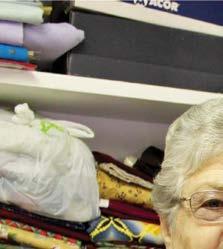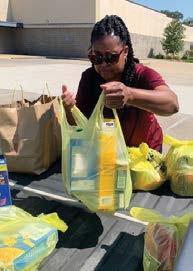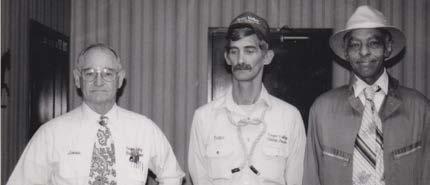









TONY KINTON’S
SONG
MISSISSIPPI AND THE POWER OF THE ARTS SMOKY, SWEET FLAVORS OF FALL











TONY KINTON’S
SONG
MISSISSIPPI AND THE POWER OF THE ARTS SMOKY, SWEET FLAVORS OF FALL
Since 2020, 100,000 rural Mississippi residents have subscribed to and received reliable high-speed internet from 17 wholly owned subsidiaries of electric cooperatives across the state.

In addition to surpassing the 100,000subscriber milestone, the 17 electric cooperative subsidiaries have collectively built nearly 25,000 miles of fiber optical cable and invested more than $760 million for high-speed internet infrastructure.
“The collective e orts of our electric cooperatives’ subsidiaries will combine to be one of the largest economic development investments in our state’s history. The benefits of this infrastructure investment will impact Mississippians for decades to come,” Electric Cooperatives of Mississippi’s CEO Michael Callahan said. ECM is the statewide organization and the voice of electric cooperatives in Mississippi.
These 17 electric cooperatives began o ering high-speed internet in 2020, so in just a short two-year time span, the cooperatives have created subsidiary organizations, secured funding, completed engineering design plans, constructed fiber lines, and are serving 100,000 rural residents with quality high-speed internet service. The number of subscribers continues to grow every day.
“The work that our cooperatives and their subsidiaries has accomplished over the past couple of years is remarkable. Reaching 100,000 subscribers collectively is an incredible milestone and a testament to the hard work of our employees across the state,” Callahan said. “As the build out for highspeed internet continues across our state, many more rural families will soon have access to reliable and fast internet service.”
Five of the state’s distribution electric cooperatives sent 83 linemen to Florida in the aftermath of Hurricane Ian to help power up the communities who were devastated after the storm.
The crews went to o er support to Peace River Electric Cooperative in Wauchula, Florida following Ian’s landfall on Sept. 28.
Coast Electric sent 29 linemen; Yazoo Valley sent

11; Dixie Electric sent 18; Delta Electric sent nine, and North East Mississippi Electric sent 16.




“Mississippi responded to Peace River’s request by sending all the equipment and personnel that they had the capacity to manage. Almost double that amount was on standby, if needed,” said Gerald Gordon, Electric Cooperatives of Mississippi’s vice president of safety and loss control.





that amount was on standby, if needed,” said Gerald

Wes Graham, a Cooperative Energy transmission field biologist, recently received the designation of “Agent” from the U.S. Fish and Wildlife Service. This designation comes with the responsibility to protect the gopher tortoise through means only allowed by designated agents.
The gopher tortoise is a federally threatened species, meaning there are numerous restrictions on respecting and preserving the species and its habitat. Graham has proved himself as a trusted conservationist on previous projects, leading the Service to grant him agent status.
Graham’s new designation allows him to scope burrows and provide aid to the gopher tortoise on Cooperative Energymanaged properties. Graham said, “This
designation comes with a big responsibility, and I’m so humbled to have received it. We have worked hard over the years to establish pristine habitats along our rightsof-way for species like pollinators and the threatened gopher tortoise. I’m proud of the ‘environmentally responsible’ tagline in our mission statement, and I do my best to uphold that every day.”
Cooperative Energy employees and contractors who work in the proximity of gopher tortoise habitats are required to attend annual training to learn how to spot and protect the species. Graham and his team should be notified of any projects occurring on Cooperative Energy rightsof-way so that proper precautions may be implemented.



The Thanksgiving and Christmas holidays bring many things to mind. Happy memories of seasons past, good food (and expanded waistlines!), great family, and long-awaited gifts. And, if you are like me, the holidays bring about thoughts of giving back, spreading love, and sharing joy.
However you share your own unique holiday spirit, know that we here at 4-County Electric Power Association strive to share our spirit with you.

We hope you see it reflected in your utility bill. Even during the holiday season – when many people are lighting their homes with festive decorations or staying up late entertaining and cooking for family and friends, we are still working to provide you with the most a ordable electric service.
We help members keep energy use in check by providing energy e ciency tips – through the use of employees, our website (www.4county.org), Facebook, and this publication, Today in Mississippi. We help you save driving time by providing the option to pay your bill through bank draft, online, with a mobile app, using kiosks in the community, or simply mailing your payment in. We also help keep your family safe by providing electrical safety tips –information that is especially important this time of year – through the direction of employees and our media resources.
We are nothing without our members. We recognize that and understand that we cannot thrive unless you thrive, so we do all we can to make sure that our community is strong.
I hope you see how much we care through the benefits, savings, and services we provide, but I also hope you see it in the ways we give back to our community. The 4-County Foundation, for example, has given back so much to the communities we serve (closing in on $2 million distributed). The 4-County Youth Leadership program has helped equip our emerging young leaders with the tools to strengthen their leadership skills. The list goes on and on. Rest assured, we’re here to serve you.
From all of your friends at 4-County, we hope you have a Happy Thanksgiving, Merry Christmas, and a Happy New Year!
 by Brian Clark
CEO/General Manager
by Brian Clark
CEO/General Manager
Helping others may give you the warmest feeling you get this chilly winter season. Warm Neighbors is a special project that gives 4-County members an avenue to help their neighbors. The ‘Warm Neighbors’ fund was created to assist 4-County members who find themselves in a onetime, emergency situation, such as an unexpected hospitalization, a job layo , or the loss of the family breadwinner.
By paying $1 extra on your 4-County electric bill, you will buy a dollar’s worth of electricity for the home of a neighbor who needs it in the nine-county area served by 4-County.

Administered by the Salvation Army, in cooperation with 4-County and area United Way agencies, Warm Neighbors funding comes solely from the voluntary contributions of 4-County members.


To participate in Warm Neighbors, contact 4-County at 1-800-431-1544.





Like the Proverbs 31 woman, quilter Betty McCa erty Barrentine of Ackerman “works willingly with her hands.”

“I have always been an arts and crafts person. My art was not with paint and brush, but art from bits of fabric sewn together into quilts and blankets,” explained Betty.
Her interest in quilting came naturally as she grew up in Choctaw County in a multi-generation family of quilters. “My two grandmothers quilted, and I watched them tirelessly. My mother joined friends each winter to quilt and help each other.”


Betty learned the basics of sewing in high school home economics, but at the time quilting wasn’t her goal. Shortly after completing Ackerman High School, she married her high school sweetheart, Bob Barrentine, who was a year older and attending Delta State College (now University).
Her interest in quilting grew as she began to stitch and design quilt tops. “I soon joined my first quilt guild where I met many friends and learned more from classes and demonstrations,” said Betty, who belongs to the Scrappers Guild in Ackerman, Red Hills of Louisville, and the Mississippi Quilt Association.
In her sewing room, she has multiple sewing machines and a quilting machine which she acquired in 2009. There are plastic tubs of fabrics given to her by friends and shelves filled with fabrics, threads, and other quilting supplies.

Quilting appeals to Betty for several reasons. Of course, there’s the creative element, but also, she considers it therapeutic and relaxing to do something constructive with her hands.
Betty said that Bob built the sewing room o his barn when her quilting outgrew the guest bedroom. “I would work on my quilting while Bob piddled on his projects in the barn.” Bob died in 2021.
“My quilting place is my happy place. Sewing is my cardio. My soul is fed with needle and thread,” related the now veteran quilter. “Sewing small pieces together gives me a peaceful heart and a quilt to wrap around you.
“Scrappy quilts and panels delight me,” she said with a smile. “However, I make all types of quilts. You see the art is in the quilt. Colors, shapes, textures, designs of fabric, threads, new or old fabrics are all options available.”
Each year Betty donates a quilt to the Chester Baptist Church Bazaar. This year’s quilt is queen size and features shades of fall – cream, orange, and greens. The Chester Holiday Bazaar is Nov. 19, from 7 a.m. to about 2 p.m. In addition to Betty’s quilt, the bazaar will o er all types of baked and canned goods plus numerous arts and crafts. The event is open to the public.
Chester Baptist Church, 177 West Road, Chester, MS, will host its annual Holiday Bazaar Saturday, Nov. 19, from 7 a.m. to 2 p.m.

This event features a wide assortment of items including, but not limited to, Christmas decorations and items to give as gifts. There will be baked goods including pies, cookies, homemade breads, and cakes. In addition, casseroles and dressings, jellies, jams, pickles, and relishes will be available for sale.
Crafts will feature jewelry, pillows, soaps, candles, paintings, cards, birdhouses, bird feeders, crosses, and much more. Gently used items will also be available along with plants and bulbs.
Breakfast items will be for sale along with soups and lunch foods for bazaar shoppers.
Proceeds from the event will be used to assist in the completion of the Chester Baptist Church playground and other church ministries.
Employees and members of 4-County Electric Power Association and FASTnet are working to make Christmas better and brighter for area children by taking part in the Toys for Tots program.
Toys for Tots, a charitable organization o ered through the U.S. Marine Corps Reserves, has maintained a partnership with 4-County the last 10 holiday seasons. Last year, employees and members dug deep and collected nearly 300 toys for distribution in 4-County’s service area.
“This is a great Christmas project,” said 4-County Communications Coordinator Brad Barr. “We’re always excited to team up the Marine Corps Reserves Toys for Tots project. A lot of children identified by Toys for Tots wouldn’t have the same Christmas experience without the help of this charitable organization and organizations like 4-County.”
Toys for Tots drop-o boxes will be located in 4-County o ces this month through Dec. 14. “All we ask is that you drop o a new, unwrapped toy in one of the boxes located in the 4-County o ce nearest you,” Barr explained.

Again, the deadline for dropping o toys is Dec. 14. Toys for Tots personnel will pick up the items by the end of that day. Call Barr at 1-800-431-1544 for more information about the Toys for Tots project. (Note: Special arrangements to pick up toy donations can also be made by calling Brad.)


Hayden Davis has joined the 4-County Electric Power Association team as Maintenance Coordinator.
Davis will be based at the Corporate Center in Mayhew. He lives in Aberdeen with his wife, Chelsie, and their children, Dani, 4, and Delta, 2. They are members of Aberdeen First Pentecostal Church.
Prior to 4-County, Hayden served as Maintenance Director for the Care Center of Aberdeen. He studied at Itawamba Community College. In his spare time, Hayden enjoys spending time with his family and being involved at his church.
Welcome to the 4-County team, Hayden!
Hayden Davis



approach to life. “You learn more by listening than asking questions,” she said. “My father taught me that.”


She readily applies that method at the 4-County Electric Power Association Call Center. A consumer service representative, Betty Sue fields up to 50 calls each day from 4-County members. “There’s no substitute for good customer service,” she stressed.


The veteran co-op employee joined the 4-County team in June 1994, first working as a cashier at the West Point Customer Service Center. Dale Parra was the district manager there, and Judy Cartee was her supervisor.
In recent years, she has moved to the Corporate Center. Prior to 4-County, she worked at Flowers by Shirley in West Point.
Betty Sue was born in the Mississippi Delta but moved to Clay County as a child. Today, she lives on 34 acres of prairie land in Cedar Blu with her husband, Eugene. “I’m a member of the yard-mowing and bush-hogging team,” she said with a laugh. They grow tomatoes there and a few jalapeno peppers. At any given time, their four grown children, four grandchildren, and four great grandchildren may be roaming the homeplace.
Betty Sue and Eugene participate in barbecue competitions four or five times a year. “I like the people and the cooking.” Boston Butts, brisket, ribs, and chicken are often on the menu. “It’s a lot of fun,” she added.
As a child, Betty Sue grew up on a farm and was involved in 4-H activities, raising and showing livestock. “It helped us stay out of trouble.” And those experiences helped her learn the value of hard work. “There’s always plenty to do on a farm.”
And there’s plenty to do at 4-County, Betty Sue said. Her job provides her unique opportunities to show concern and empathy. “I’m a people person. I care. That’s me. Our members are a part of my life,” she explained. “I’ve never really met a stranger.” Betty Sue has many vivid memories of her years of customer support. Staying all night answering phones when Hurricane Katrina rumbled through Clay County is one that sticks out.
Good customer service is trying to give the members plenty of information and options, Betty Sue said. She enjoys those opportunities. “4-County has been a blessing. It’s been the best job I’ve ever had.”
Five area high school juniors were recently selected through an interview process to represent Central Electric Power Association during an upcoming statewide leadership workshop in Jackson, MS, and the annual National Rural Electric Cooperative Association Youth Tour in Washington, D.C. this summer.
Now in its 35th year, the Electric Cooperatives of Mississippi Cooperative Youth Leaders program is an enjoyable educational experience that makes a lasting impact on participants.
Students LEARN the value
business
GROW in their
qualities

EXPERIENCE the democratic process at state

by visiting the Mississippi and U.S. capital cities.


Drew is the son of Andrew and Jacqueline Kelly of Carthage. He attends Leake Central High School. After graduation, Drew plans to attend Mississippi State University to pursue a computer science degree.

Keondrae is the son of Kelby and Kendra Anderson of Conehatta. He attends Choctaw Central High School. After graduation, Keondrae plans to attend college and pursue a degree in bio-chemistry.

Maggie is the daughter of Mark and Amy Taylor of Philadelphia. She attends Neshoba Central High School. After graduation, Maggie plans to attend the University of Mississippi to pursue a degree in biology.

Sara is the daughter of Randy
Carthage.

attends Leake Academy.
graduation,

plans
become


Kendall is the daughter of Scott and Hope Welch of Brandon. She attends Pisgah High School. After graduation, Kendall plans to join the air national guard and pursue a
as a flight

Christmas Tree Lighting
Kosciusko Downtown Square November 17, 2022 5:30 p.m.
The KAP o ce & local businesses will be open November 20, 2022 1-5 p.m.
Merry Market Place KAP O ce November 20 through December 21, 2022
Christmas Parade Downtown Square December 5, 2022 6:30 p.m.
The Square December 8 & 15, 2022 starting at 5 p.m.
Christmas Open House
November 13, 2022 1-7 p.m.
Lighting of Trustmark Park food trucks, a free train ride, a new 30 foot Christmas Tree, & a free concert by Todd Tilghman November 28, 2022 5-9 p.m.
Carthage Christmas Parade December 1, 2022 6 p.m.
Holiday Open House November 13, 2022 1-5 p.m.
Third Thursday November 18, 2022 5-8 p.m.
Small Business Saturday November 26, 2022
Philadelphia Christmas Parade Downtown December 5, 2022 6 p.m.
Moonlight Madness December 15, 2022 6-9 p.m.
The McElroy Hoye House Newton, MS November 4, 2022
Cookie Work Shop - adults
The McElroy Hoye House Newton, MS November 10, 2022
Christmas Open House at Dezignz by Nikki
Downtown Newton, MS November 11 & 12, 2022
Hickory Pick’N Day Hickory Pick’N Flea Market Hickory, MS November 12, 2022 9 a.m. - 4 p.m.
Downtown Newton, MS November 18, 2022
The McElroy Hoye House Newton, MS November 21, 2022
After Thanksgiving Sale at Dezignz by Nikki Downtown Newton, MS November 25, 2022
Christmas Tree Lighting Ray Payne Park Downtown Newton, MS November 29, 2022

Newton Christmas Parade Newton, MS December 1, 2022
Decatur Christmas Parade Decatur, MS December 2, 2022
Union Christmas Parade Union, MS December 3, 2022
“A Christmas Story”
Historic Newton Depot at the Gazebo Area December 17, 2022
Chamber’s Chili Cook-O & City’s Grand Lighting Winner’s Circle Park December 1, 2022


Central Electric’s office will be closed November 24 and 25 for Thanksgiving.

To report an outage, please visit www.centralepa.com and click on Report An Outage, call 601-267-3043, or text the word OUT to 866-846-5671 if you are enrolled in the outage texting service. A dispatcher is on duty 24 hours a day, 7 days a week.











If you are hosting guests, your household will consume more electricity than normal. Be prepared with e ciency basics:
• Have your thermostat programmed at 68 degrees when you are home and dialed back 8 to 10 degrees when you leave the house or go to sleep.


• Run the clothes washer on cold with full loads.


• When not in use, turn o lights and the TV; fully shut down computers and gaming systems instead of putting them in sleep or standby mode.

• Lower the thermostat when guests are over or cooking food. Most gatherings happen in the center of the home, so save energy by turning the heat down in areas you are not using.

This year, make the switch to LEDs for all your holiday lighting. LED holiday lights consume 70% less energy than conventional incandescent light strands. For example, it costs 27 cents to light a 6-foot tree for 12 hours a day for 40 days with LEDs compared to $10 for incandescent lights.

Pick up a few light timers so you don’t have to remember to unplug your lights every evening. You can also choose to upgrade to smart holiday lights that o er a wide range of app-controlled options, including time, colors, music, and modes.

The holidays are a magical time when we come together with our loved ones to share food, gifts, and quality time. It’s also the most expensive time of year for many of us. Along with the expense of gifts, meals, and travel comes colder weather and darker nights that lead to more electricity use and higher bills.
One way to reduce the financial burden of the most wonderful time of year is by implementing e ciency tips to use less energy at home and lower your monthly bills.
Whether you are making holiday treats or a feast, here are a few tips to help lower energy use in the kitchen.
Use the oven light to check food. Every time the oven door is opened, the temperature inside is reduced by up to 25 degrees, according to the Department of Energy (DOE). When possible, make use of a slow cooker, microwave, toaster oven, or warming plate, which use less energy than an oven and stovetop. According to DOE, a toaster oven can use up to half the energy of the average electric stove over the same cooking time.
Let hot food cool to room temperature before placing it inside the refrigerator. This ensures you don’t increase the temperature inside your fridge and cause it to use more energy to cool down. You can also take some of the stress and expense out of your holiday cooking by asking guests to bring a dish.



If you’re visiting family and friends during the holidays, prepare your home to use less energy while you’re away.
Water heating is the second-largest energy expense in your home, accounting for about 18% of your utility bill, according to DOE. Switching your water heater to vacation mode will reduce wasted energy by keeping the water at a lower temperature. If your water heater does not have vacation mode on the dial, you can adjust it to the lowest setting.
Set your thermostat to around 55 degrees so you’re not wasting energy to heat the home while you’re away.
Instead of leaving lights on all day, consider upgrading a lamp or fixture to a smart lightbulb. This allows you to control lights from afar and set a schedule for the light to go on and o . Another option is to repurpose your holiday light timer for one of your living room lamps.
Lower your energy bills this holiday season with these simple e ciency tips. Happy Holidays!



Miranda Boutelle is the vice president of operations and customer engagement at E ciency Services Group in Oregon.
















Pumpkins are part of the plant family known as gourds. They are typically a large edible fruit with tough skin. Did you know every single part of a pumpkin is edible? Yep, you can eat the skin, leaves, flowers, pulp, seeds, and even the stem.
Pumpkins are symbols of prosperity, growth, and abundance. So, the bigger the better! The whole pumpkin represents the world we live in now and is literally filled with blessings waiting to be granted. Each seed represents an opportunity available to you in this life and with the average pumpkin having about 500 seeds, you can literally count your blessings.


Dreaming of pumpkin seeds is believed to be deeply connected to providing reassurance for a decision or goal pursued. If you dream of a whole pumpkin, it usually symbolizes openness to new possibilities and encouragement to try new things.
The saying, “I heard it on the pumpkin vine,” ties directly into friendships and connections. As the pumpkin receives all its nutrients from the ground through the vine, we gain social and spiritual “nutrients” through the vine of friendship by helping us grow deeper in many aspects as individuals. A strong “vine” or connection with our beliefs can strengthen our faith, and we can better connect with the world around us and help others find their way.
The natural and unique shape of pumpkins adds to endless creative ideas. It’s easy to lose ourselves in decorating as we’re transitioning into a new season. Pumpkins don’t come in one color. There are tons of di erent meanings associated with the di erent colors. Orange is the traditional color of pumpkins. Purple represents epilepsy awareness; pink is known for breast cancer awareness; red is famous for the Cinderella pumpkin, and teal signifies food allergies and allergy friendly candy and treats. The blue pumpkin, better known as the Australian blue pumpkin, is used to show support for autism and local law enforcement o cers or residents who do not participate in trick or treating.
Let’s look at how employees of Coahoma Electric display their distinct individuality for this fall season.








Coahoma Electric Power Association will hold its Annual Meeting of the Membership at 10 a.m. Thursday , Feb. 9, 2023, at Coahoma Electric’s Headquarters multipurpose room at 3355 Rudyard-Jonestown Rd, Coahoma, MS 38617. This new location is approximately 1 mile North of Coahoma County Airport on Highway 61. The following is an excerpt from the association’s bylaws pertaining to the Annual Meeting of the Membership.

• Section 3.01. Annual Meeting.
For the purposes of electing Directors, hearing and passing upon reports covering the previous fiscal year, and transacting such other business as may properly come before the meeting, the annual meeting of the Members shall be held on the second Thursday of February of each year, at such place in Coahoma County, Mississippi, and beginning at such hour, as the Board of Directors shall, from year to year, fix; PROVIDED, that, for cause su cient, the Board of Directors may fix a di erent date for such annual meeting not more than thirty (30) days prior or subsequent to the day otherwise established for such meeting. Failure to hold the annual meeting at the designated time and place shall not work a forfeiture or dissolution of the Association.
• Section 3.02. Special Meetings.
Special meetings of the Members may be called by a majority of the Board of Directors, or upon written petition submitted to the Board of Directors signed by at least three hundred (300) Members; any such petition(s) shall be submitted on forms provided by the Association, and the same shall be signed, completed and verified in the same manner as are petitions submitted under Section 4.04 of these Bylaws. Special meetings shall be held at such place within Coahoma County, Mississippi, on such date, and at such hour as the Board of Directors shall fix and determine, and the Association’s Secretary shall cause notice of any such meetings to be given as hereinafter provided.
• Section 3.03. Notice of Members’ Meetings.
Written or printed notice stating the place, day and hour of the meeting and, in the case of a special meeting or of an annual meeting at which business requiring special notice is to be transacted, the purpose or purposes of the meeting shall be delivered to each Member not less than fifteen (15) days nor more than twenty-five (25) days prior to the date of the meeting, either personally, by mail, or electronically, by or at the direction of the Association’s Secretary, or by the directors or members calling the meeting. Written notice of any meeting at which the Association’s certificate of incorporation will be voted on by the Members must be sent to the Members at least
thirty (30) days prior to the date of the meeting, and shall identify and describe the purpose of the amendment. If Directors are to be elected at such meeting, the notice of Members’ meeting shall include a statement of the members of the Board of Directors to be elected as provided in Section 4.04. Unless specified in such notice of meeting, no matter may be acted upon at such meeting. If mailed, such notice shall be deemed to be delivered when deposited in the United States mail, addressed to the Member at his or her address as it appears on the records of the Association, with postage thereon prepaid. The failure of any Member to receive such notice shall not invalidate any action which may be taken by the Members at any such meeting.
• Section 3.04. Quorum.
Three hundred (300) Members shall constitute a quorum at any regular or special meeting of Members. This number shall be arrived at by adding the number of Members present in person at the meeting to the number of Members represented at that meeting by valid proxies filed as provided by these Bylaws. If less than a quorum is present at any meeting of Members, the o cer of the Association who is presiding at the meeting may, at the time stated in the notice and without a motion, declare the meeting adjourned and closed or he may hold the meeting open for not longer than thirty (30) minutes to see if a quorum is present within that time; and the meeting shall automatically be adjourned and closed if a quorum shall not be present at the end of said thirty (30) minute period. The Members present at a meeting at which a quorum is not present shall not have the power to take any kind of action, including, but not by way of limitations, adjourning said meeting to another time or place.
• Section 3.05. Voting.
Each Member who is not in a status of suspension, as provided for in Section 2.01, shall be entitled to only one vote upon each matter submitted to a vote at any meeting of the Members. A Member may vote at any such meeting either in person or by proxy. At a meeting of the Members where Directors are to be elected, all Members present in person or by proxy may cast one (1) vote for each Director to be elected; each Member may vote his or her own vote plus those proxies executed in such Member’s favor, pursuant to Section 3.06 and 3.07 of these Bylaws. Voting by Members other than Members who are natural persons shall be allowed upon the presentation to the


Association, prior to or upon registration at each Member meeting, of satisfactory evidence entitling the person presenting same to vote. At all meetings of the Members, all questions shall be decided by a majority of the Members voting thereon, except as otherwise provided by law or by the Association’s Certificate of Incorporation or these Bylaws or any amendment(s) thereto. Members may not cumulate their votes.
• Section 3.06. Proxies.
At all meetings of the Members, a Member may vote by proxy executed in writing and signed by the Member, subject to the provisions hereinafter set forth, provided, however, any Member intending to vote by proxy must file the executed proxy at the Association’s headquarters by the close of business on the later of the Monday preceding the annual or special meeting or three (3) business days prior to such meeting. A Member may personally deliver his or her proxy to the said o ces of the Association or mail the proxy by United States Mail, postage prepaid, addressed to the Secretary, Coahoma Electric Power Association, P. O. Box 188, Lyon, Mississippi, 38645. If the proxy is sent by mail, the date of its receipt in the Association’s o ce at the above address shall be its filing date. The proxy must have entered thereon the name and account number of the member appointed to vote the proxy. No proxy shall be voted at any meeting of the Members unless it shall designate the particular meeting at which it is to be voted, and no proxy shall be voted at any meeting other than the one so designated, or any adjournment of such meeting. No proxy shall be voted by anyone except a Member. A Member may appoint any other individual Member to vote his or her proxy, or a Member may appoint the individual members of the Board of Directors, collectively, to vote said proxy. No Member shall vote as proxy for more than fifty (50) Members at any meeting of the Members. In the event an individual Member is appointed to vote as proxy for more than fifty (50) other Members, such proxies in excess of fifty (50) shall be assigned to the Board of Directors for voting; and the proxies so assigned and those proxies appointing the individual members of the Board of Directors shall be voted according to the will of a majority of the Board of Directors. The presence of a Member at a meeting of the Members shall revoke a proxy theretofore executed by that Member, and such Member shall be entitled to vote at such meeting in the same manner and with the same e ect as if the proxy had not been executed. In case of a joint membership, a proxy may be executed by either spouse. The timely presence of either spouse at a meeting of the Members shall revoke a proxy theretofore executed by either of them and such joint Member (or Members) shall be entitled to vote at such meeting in the same manner and with the same e ect as if a proxy had not been executed. A standard proxy form shall be used which identifies the Member by name and Member number, in order to assure authenticity and facilitate the tabulation of votes. If the proxy form of a Member is
lost, stolen, or destroyed, the Association shall furnish such Member with a replacement proxy form upon request, provided that the Member executes a revocation of the lost, stolen or destroyed form, to be witnessed by an employee of the Association. Blank proxy forms will not be distributed in bulk to any Member. Designation of proxies shall be upon forms prescribed by the Board of Directors and furnished by the Association and no other forms shall be recognized or accepted.
• Section 4.04. Committee on Nominations.
Thursday, Feb. 9, 2023 at 10 a.m.
Coahoma Electric’s Headquarters • Coahoma, MS
(a) It shall be the duty of the Board of Directors to appoint, no less than forty (40) calendar days nor more than ninety (90) calendar days before the date of the meeting of the Members at which Directors are to be elected, a Committee on Nominations consisting of not less than five (5) nor more than eleven (11) Members who shall be selected with consideration being given to provide geographic representation of the Association’s service area. No existing Association employees, agents, o cers, Directors or known candidates for Director, and close relatives (as hereinafter defined) or members of the same household of existing association employees, agents, o cers, Directors or known candidates for Director may serve on such committee. The Committee on Nominations shall receive and consider any suggestion as to nominees submitted by Members. The Committee on Nominations shall meet at a time and place set by the Board of Directors. The Committee on Nominations shall prepare and post at the principal o ce of the Association at least thirty-five (35) calendar days before the meeting a list of nominations for Directors. The Secretary must mail with the notice of the meeting or separately a statement of the number of Directors to be elected and the names and addresses of the candidates nominated by the Committee on Nominations.
(b) Nominations By Petition. Any fifty (50) Members acting together may make a nomination by petition and the Secretary shall post such nomination at the same place where the list of nominations by the Committee on Nominations is posted. Any petition for nomination shall be submitted on a form designated and provided by the Association. Each Member signing such petition shall place thereon the date of signing, address and account number of the Member. The Secretary shall mail with the notice of the meeting or separately a statement of the number of board members to be elected and the names of candidates nominated by the committees and the names of candidates nominated by petition, if any. Nominations made by petition, if any, received by the close of business at least 90 calendar days before the annual meeting shall be included on the o cial ballot. No petition may contain more than one nominee.
(c) Notwithstanding anything in this Section, failure to comply with any of the provisions of this Section shall not a ect in any manner whatsoever the validity of any election of Directors.
Reggie Hibbler Hamp Bass Robert A. Boyce William Peal Harvey B. Rodgers Jr. Ann Ruscoe Tommy Sides Members of Coahoma EPA’s Committee on Nominations




































There is much to celebrate in November. I am grateful to all of those who have served our country in the military. We know you have sacrificed so much – not just for people you know and love – but for thousands of your fellow Americans. May we never take your service and sacrifice for granted.





I am also thankful for the safe return of the crew members who went to Florida to assist crews at Peace River Electric in Wauchula after Hurricane Ian. They know what it’s like to face the aftermath of a devastating storm. They also know what it’s like to restore power and hope to their communities. I am proud of the work they did and will pray for the recovery of everyone a ected by this storm.
This month also marks the second anniversary of CoastConnect. For two years, we’ve seen lives change for rural residents who were overlooked by other service providers. It’s been an amazing e ort by hundreds of people working to make a di erence in our community. And it’s paying o . We’ve got plenty of work left to do,

but we’re working ahead of schedule to build our high-speed fiber system. I know many of you are still eager for service, and we are working every day to make sure every Coast Electric member can connect with CoastConnect. Thanks to all of you for supporting our e orts. We know it’s a privilege to serve you, and we will continue to provide the service you expect and deserve.
Of course, we are looking forward to the Thanksgiving holidays and hope you and your loved ones have a healthy and happy holiday. Serving you is a blessing to me, and I am thankful to be part of your cooperative.
In partnership with CoBank, a national cooperative bank that serves utilities in rural America, Coast Electric Power Association and its high-speed internet subsidiary, CoastConnect, have issued grants to local non-profit organizations through CoBank’s Sharing Success program. The program helps cooperatives nationwide give back to charities in their local communities, which is an important focus for and operating principle of co-ops like Coast Electric.
This year, Coast Electric and CoastConnect personnel proposed matching grants for The University of Southern Mississippi (USM) Children’s Center for Communication and Development, Lynn Meadows Discovery Center and three local volunteer fire departments. The cooperative was able to secure $14,800 in funds from CoBank, for a total donation of $29,600 for Coast Electric and CoastConnect to distribute.
Lynn Meadows Discovery Center and The USM Children’s Center for Communication and Development each received a $10,000 grant from Coast Electric, while Amackertown, Steephollow and North Central volunteer fire departments in Pearl River County received $3,200 each from CoastConnect.



At Lynn Meadows, the grant will be used for scholarships so local students can benefit from the educational programming o ered by the center.









The USM Children’s Center aims to create a Parent Resource Center that would include a variety of developmentally appropriate books, toys and adaptive toys, and children’s books written in other languages. Parents will be able to check out the materials to use in their homes to reinforce what children learn in weekly therapy. The grant will also be used to fund essential interpretation services for weekly sessions and to make materials available in other languages.
The fire departments will use their funds for Automated External Defibrillators (AED). These organizations are operated by volunteers who give their time to respond to a wide variety of incidents. Volunteers are often on the scene several minutes ahead of medical professionals and must make critical decisions regarding immediate care for the patient until the ambulance arrives. The AEDs will provide a critical, life-saving tool for first responders.
“The Sharing Success program allows Coast Electric and CoastConnect to support local organizations that don’t have the fundraising power of national charitable organizations,” said Coast Electric Community Development Director Janell Nolan. “This partnership with CoBank allows us to further our mission of improving life in our local community, while bringing attention to organizations that are making a positive di erence in the lives of people in Hancock, Harrison and Pearl River counties.”





Coast Electric crews traveled to Wachula to help sister cooperative Peace River Electric restore service to their members after Hurricane Ian devastated the area in September. The co-op serves approximately 55,000 homes and businesses. At the height of the storm, 88% of their members were without power. Coast Electric and Peace River have a history of helping one another after storms. Lending a helping hand is part of what being a co-op is all about, and we are proud to be part of the restoration effort in Florida.

A new charging station is serving electric vehicle (EV) drivers living in and visiting Pearl River County. The charging station, made possible by Coast Electric and Cooperative Energy, features a level 4 charger, which is the fastest EV charger available, and will soon offer additional level 2 chargers that power vehicles at a slower pace.

“With more EVs on the road than ever before, we want to make it easy for EV drivers to access charging stations in rural areas,” said Coast Electric President and CEO Ron Barnes. “This
partnership with a local business like Paul’s Pastry is a win for everyone. It gives residents and visitors a convenient place to charge their cars while they enjoy eating or shopping at Paul’s and other stores in the area. Coast Electric was formed more than 85 years ago to make sure rural residents had access to electric service. Today, we are still working to make sure rural residents have the same access to services as those who live in urban and suburban areas.”

JANUARY 2019: The Mississippi state legislature makes it possible for electric cooperatives to o er highspeed internet service to members.

JULY 2020: Coast Electric receives CARES Act funds for a fiber internet pilot project in Pearl River County.
AUGUST 2020: Coast Electric members vote for the co-op to form CoastConnect and provide high-speed internet service to co-op members.
NOVEMBER 2020: CoastConnect employees connect the first subscriber.
SEPTEMBER 2021: More than 3,200 subscribers are connected.
SEPTEMBER 2022: CoastConnect welcomes its 10,000th subscriber.
This fall, CoastConnect connected its 10,000th subscriber. That’s 10,000 homes and businesses that are working, streaming, gaming, downloading, learning and more with our reliable, lightning-fast internet service. We are proud of this milestone and will continue building our state-of-the-art fiber system until every Coast Electric member has access to CoastConnect service.
Meet Louis Graham, the owner of Sho-Nu BBQ, a local minister and CoastConnect’s 10,000th subscriber!

We are proud to serve Mr. Graham and his family.
“I recommend CoastConnect to anyone who wants great internet service,” said Graham.


Coast Electric and CoastConnect will be closed Thursday and Friday, Nov. 24-25, for the Thanksgiving holidays.


We wish you and your families a happy, healthy holiday!


Coast Electric wants you to reduce your energy use and see savings on your energy costs. Each month, you will have an opportunity to register to win a prize that will help you reduce the energy consumption in your home. All you have to do is visit www.coastepa.com and fill out our entry form. It only takes a few seconds, and you could win a prize that helps you save!
Congratulations to Ola Holland, the winner of our September Reduce Your Use prize!
This month, I’d like to share a few simple ways you can make your home more comfortable this winter, which can ultimately help you save on energy bills.
At the onset of the cold weather season, we replace the HVAC filter for better air quality and to help the unit operate more e ciently. You can also keep your home cozier by caulking and weatherstripping windows and doors. If your home is particularly chilly, you can tape or a x heavy, clear plastic to the inside of your window frames to create an additional barrier against the cold. Ensure that the plastic is tightly sealed to the frame to help reduce infiltration.


We know winter can be “ru ,” so we set our thermostat at 68 degrees, a “purr-fect” temperature for people and pets. This is especially important for smaller, short hair and senior dogs — not just for warmth, but for their general health. Puppies, kittens, and older pets with arthritis or other ailments may have a harder time controlling their body heat and need the additional warmth when it’s chilly out.
Pets that sleep close to the floor can be subject to cold drafts that enter your home through windows and exterior doors. If your pet’s bed is near a window or door that feels drafty, tightly roll up a towel and place it near the bottom of the door or window to eliminate the draft. Cutting down on cold drafts helps everyone feel more comfortable during colder months.

If possible, elevate your pet’s bed so it’s not placed directly on a cold floor. An old chair or sofa cushion works well. If you don’t use

a dog bed, take some old blankets and create a donut shape on the cushion so the dog can snuggle and “nest” within the blanket. You can do the same for cats but on a smaller scale. Blankets enable pets to nestle into them, even when they aren’t tired, and provide a comfortable place for dogs and cats to curl up.
Blankets

During the day, open your blinds and curtains to allow sunlight to warm your home. Close window coverings at night for an added layer of insulation.

At Delta Electric, we want to help you save energy and money. Check out our app, Delta EPA, or visit our website at deltaepa.coop for additional energy-saving tips.






We can’t control the weather, but we can provide advice to help you save energy and keep your family and furry friends more comfortable during the winter season.
by David O’Bryan General Manager
General Manager










 by Katherine Loving
by Katherine Loving
Whether you’re a master chef or a culinary novice, smart appliances add convenience to any kitchen. Smart kitchen appliances can guide you step-by-step or even perform the cooking themselves.
Smart appliances typically rely only on Wi-Fi (paired with a custom smartphone application), while others can work with common smart home systems like Google Home or Amazon Alexa. Smart home systems establish routines based on our activity, like





Induction cooktops are an innovation in themselves. Induction cooking works by delivering energy directly to cookware, using a magnetic field that warms the inside of cookware specifically made for induction cooking. Induction cooktops are 32% more energy e cient than gas cooktops and about 75% more e cient than electric cooktops.
Like other smart cooktops, smart induction models recognize when a pan is placed on an element and automatically turn o when a pan is removed from the cooktop. Brands like Samsung and Bosch o er additional smart functions like synchronization of the cooktop with a (brand-matched) smart ventilation hood. The smart hood activates as soon as cooking begins and adapts to cooking intensity on the fly. Smart Ranges can also include this function and often feature a barcode scanning system that allows you to scan storebought foods, prompting the oven to start based on the instructions.
Smart ranges can be controlled remotely to preheat, change, and monitor temperatures through the companion app, or an integrated home system. A few brands o er a Wi-Fi connected cooking thermometer to allow remote monitoring, leaving the home chef free to do other things while an app keeps an eye on cooking progress.
For novice chefs, many smart ovens and cooktops have guided step-by-step recipes within the app to help control the cook time and temperature.
Induction cooktops, like the Samsung model shown here, transfer heat directly to the cookware, which is specially made for induction cooking.

Photo credit: Samsung
when we return home from work. You can set smart devices to begin a programmed routine to turn on lights, adjust the thermostat, and other tasks.
For smart kitchen appliances, routines could include preheating an oven, or turning on a co ee maker. Let’s take a look at a few smart appliances for the home chef.
Like other smart cooktops, smart induction models recognize when a pan is placed on an element and automatically turn o when a pan is removed from the cooktop.


Manufacturers are adding smart functionality to their countertop cooking options as well. The June Oven includes an in-oven camera that allows progress to be tracked from its app. The app also provides progress monitoring with push notifications to your phone when cooking is complete.

Tovala also o ers a smaller, countertop oven for ready-to-cook meals. These ovens use barcode scanning technology for both Tovala meals and those from the grocery store. The Tovala app also uses push notifications to track progress.
Like Tovala, the Breville smart oven o ers guided recipes and an app that directs cooking temperature and function, such as air fry or bake, as the recipe advances. The Breville smart oven also uses its on-board chip to monitor and stabilize temperature from all sides for more e cient cooking.
Other common kitchen appliances and small devices are getting smart, too. However, these devices feature a smaller set of functions than those mentioned above.
Microwaves from manufactures like LG, Whirlpool, GE, Sharp, and Toshiba include the barcode scanning function to allow product-specific cooking instructions to be sent to the appliance.

Smart kitchen scales, air fryers, and pasta makers are also all available to connect to your phone for guided measuring and cooking.
If you’re looking for a smart kitchen gadget that won’t break the bank, try a smart meat thermometer. These handy little devices work with an app to specify optimal cook time and temperature, and they notify the chef when the meat is ready.
Smart co ee makers like the Hamilton Beach model shown here can connect to Amazon Alexa or Google Home with smart functions to set brew schedules and brew strength. Photo credit: Hamilton Beach
As our appliances and kitchen gadgets get smarter, home chefs will have more options for convenience and functionality. Bon appétit!










If you are hosting guests, your household will consume more electricity than normal. Be prepared with e ciency basics:
• Have your thermostat programmed at 68 degrees when you are home and dialed back 8 to 10 degrees when you leave the house or go to sleep.

• Run the clothes washer on cold with full loads.



• When not in use, turn o lights and the TV; fully shut down computers and gaming systems instead of putting them in sleep or standby mode.




• Lower the thermostat when guests are over or cooking food. Most gatherings happen in the center of the home, so save energy by turning the heat down in areas you are not using.

This year, make the switch to LEDs for all your holiday lighting. LED holiday lights consume 70% less energy than conventional incandescent light strands. For example, it costs 27 cents to light a 6-foot tree for 12 hours a day for 40 days with LEDs compared to $10 for incandescent lights.

Pick up a few light timers so you don’t have to remember to unplug your lights every evening. You can also choose to upgrade to smart holiday lights that o er a wide range of app-controlled options, including time, colors, music, and modes.

The holidays are a magical time when we come together with our loved ones to share food, gifts, and quality time. It’s also the most expensive time of year for many of us. Along with the expense of gifts, meals, and travel comes colder weather and darker nights that lead to more electricity use and higher bills.
One way to reduce the financial burden of the most wonderful time of year is by implementing e ciency tips to use less energy at home and lower your monthly bills.

Whether you are making holiday treats or a feast, here are a few tips to help lower energy use in the kitchen.
Use the oven light to check food. Every time the oven door is opened, the temperature inside is reduced by up to 25 degrees, according to the Department of Energy (DOE). When possible, make use of a slow cooker, microwave, toaster oven, or warming plate, which use less energy than an oven and stovetop. According to DOE, a toaster oven can use up to half the energy of the average electric stove over the same cooking time.
Let hot food cool to room temperature before placing it inside the refrigerator. This ensures you don’t increase the temperature inside your fridge and cause it to use more energy to cool down. You can also take some of the stress and expense out of your holiday cooking by asking guests to bring a dish.


If you’re visiting family and friends during the holidays, prepare your home to use less energy while you’re away.
Water heating is the second-largest energy expense in your home, accounting for about 18% of your utility bill, according to DOE. Switching your water heater to vacation mode will reduce wasted energy by keeping the water at a lower temperature. If your water heater does not have vacation mode on the dial, you can adjust it to the lowest setting.
Set your thermostat to around 55 degrees so you’re not wasting energy to heat the home while you’re away.
Instead of leaving lights on all day, consider upgrading a lamp or fixture to a smart lightbulb. This allows you to control lights from afar and set a schedule for the light to go on and o . Another option is to repurpose your holiday light timer for one of your living room lamps.
Lower your energy bills this holiday season with these simple e ciency tips. Happy Holidays!
Miranda Boutelle is the vice president of operations and customer engagement at E ciency Services Group in Oregon.

Every November 11, our nation comes together to remember and honor the service and sacrifices of our veterans. For me, it’s a time to reflect on and honor the heroic men and women of the Armed Forces, to remember those who paid the ultimate sacrifice, and to pay homage to those currently serving.
First, I would like to recognize a Dixie Electric employee who is also a veteran. Adron Presley, a line foreman in Laurel, served with the Marines from 1993 until 1999. Military service instills a strong work ethic, loyalty, decisiveness, and a spirit of collaboration, which are also qualities that Adron brings to his role at Dixie Electric. On behalf of our employees, directors, and members, I want to thank Adron for his service.
I would also like to thank those of our members who are veterans for their willingness to serve. Your service to our country is greatly appreciated, and we would like to honor your service by inviting you to stop by any Dixie Electric o ce on






Friday, November 11, to receive a token of appreciation and gratitude on behalf of our membership.










At Dixie Electric, we pride ourselves on powering our communities, but veterans are the ones who empower us. We are grateful for our veterans who have dedicated their lives to protecting our country. Through their service, they have made an enormous contribution to our nation that we can never repay. To those in uniform serving today and those who have served in the past, we honor you today and every day.
by Randy Smith General Manager

 by Amanda Mills
by Amanda Mills
After a relatively quiet hurricane season, Hurricane Ian brought damaging wind, heavy rain, and storm surges to Florida when it made landfall as a Category 4 hurricane on Wednesday, Sept. 28. An esti mated two million Floridians lost power during the storm.
Peace River Electric Cooperative (PRECO), located in Wauchula, Florida, serves over 55,000 meters in the south-central portion of Florida. PRECO reported more than 49,000 members without power at the height of the outages, which is 88% of the meters they serve. PRECO requested assistance, and Dixie Electric responded by sending linemen, bucket trucks, a track machine, and other support vehicles.

On Thursday, Sept. 29, 18 Dixie Electric employees, including two

Cooperation Among Cooperatives is one of the seven guiding Cooperative Principles, with mutual aid being a vital part of who Dixie Electric is as a cooperative. “During Hurricane Katrina, we couldn’t have done what we were able to do without the help of mutual aid,” added Ulmer. “We are glad to be able to go and help those in need in Florida.”






 by Amanda Mills
by Amanda Mills
For over a decade, 11th-grade students from local high schools have attended Dixie Electric’s Cooperative University to learn about cooperatives, the electric power industry, and expand their leadership skills.






Thirty high school juniors, representing 11 high schools, attended the fun-filled day on Tuesday, Oct. 4. Cooperative University is the first step in a leadership-building process. From this group, judges selected 19 students to participate in a one-on-one interview to choose students to represent Dixie Electric as the 2023 Cooperative Youth Leaders. These students will attend a three-day leadership workshop in Jackson in March and a weeklong, all-expense-paid trip to Washington, D.C. in June.
“Cooperative University is always a fun day here at Dixie Electric,” said Community Relations Coordinator Pollyanna
Magee. “Each year, we get an amazing group of kids, and this year was no exception. Their excitement, personalities, and participation make the day a success.”
During the morning session, Magee led the students in several rounds of games to get to know one another. The students also heard a presentation from Cooperative Energy’s Tonya Williams, who explained how power is generated, transmitted, and distributed to the members of Dixie Electric.
The morning session ended with a panel discussion with state legislators. Senators Joey Fillingane and Dennis DeBar joined Representatives Dale Goodin and Donnie Scoggin to participate in a legislative panel where students were allowed to ask questions about current events in our state and nation.




















Recently I helped my son remove all the shrubbery from around his home. To ensure we were able to complete the project in a single day, my son rented an excavator to help speed the process along.
After unloading the excavator, we began the day’s work. Now, for those of you that have not used a piece of equipment that has only a few handles that move a lot of things in a lot of directions, you may have a di cult time envisioning what the process looks like. There are two levers in the center of the dashboard that make the machine travel forward and backward. The left lever controls the track on the left and the right lever controls the track on the right. To move forward, you push both levers forward. To go backward, you pull back on both levers. Sounds simple enough. And it is, until you use a third lever to swing the bucket and arm 180 degrees to the back of the machine.
Once you are facing in the opposite direction on the machine, the left lever moves the track on your right and the right lever moves the track on the left. Additionally, to go forward you must pull back on the levers and to move backwards you push them forward. Suddenly, the process is not as simple. Now much more thought is needed to avoid colliding with the front of the house.
Complex machines like an excavator incorporate lots of moving parts that, when used properly, can create huge gains in productivity and help us achieve great things. But, when the communication channels get crossed up between what our brain wants the machine to do and what our hands tell it to do, damage can occur.
There is no more complex machine than an organization made up of many people. Operating the machine gave me time to reflect on





the messages I send to others each day. Just as I sometimes pushed one of the levers instead of pulling the lever on the excavator and moved in the opposite direction I intended, messages sent are not always the message received.

We work diligently to send the right messages to you, our members. Tools like our website and Facebook page help us communicate information quickly when outages occur. This very magazine communicates helpful safety and energy savings tips, recipes, and useful information each month.




Dedicated employees, at both East Mississippi Electric Power Association and East Mississippi Connect, answer hundreds of calls each day and strive to provide you with the information you need and want. It is our intent to deliver valuable, honest and sincere information in the most understandable manner possible. If we do sometimes push the lever in the wrong direction, please contact us and give us the opportunity to correct it.
After all, it is our mission of delivering services to empower lives as we build pathways for community success that defines your EMEPA cooperative.
by Randy Carroll CEO — East Mississippi Electric Power Association



East Mississippi Electric Power Association celebrated 84 years of service to East Mississippi during its recent annual meeting in Meridian.
“When community members came together to create cooperatives to serve their electric needs, they were grateful to add light bulbs in rooms, refrigerators that did not require a trip into town to purchase a block of ice, clothes’ washers and later clothes’ dryers,” said EMEPA CEO Randy Carroll. “History shows us what can be accomplished when good people come together to serve their communities.”
“The annual gathering is a vital part of EMEPA’s governance,” Carroll noted. As an electric cooperative, the association is democratically controlled, with each member having one vote.
At the meeting, EMEPA members voted in accordance with the bylaws of the association to re-elect David Sorrels of Kemper County, Jerry Webb of Winston County, and Chester Willis
South System At-Large to each serve a three-year term on the EMEPA Board of Directors.


Local democratic member control is one of the cooperative principles by which EMEPA has thrived for 84 years and why it continues to enjoy a strong place of trust in the community.
“How do we continue being successful? Simply stated, it is your support,” Carroll told members. “Signing up for the service and utilizing the fiber network ensures our communities remain part of a vibrant state-of-the-art communication network — a network that is core to attracting new businesses, job opportunities and people to our area.”
Two $250 electricity credits and one $500 electricity credit were given in a drawing as prizes to EMEPA members in attendance. Additionally, four EMEPA members, one from each district, won a $500 electricity credit for returning the 84th annual meeting proxy.


the following
members
winning electricity credits!
annual meeting.Winner












If you are hosting guests, your household will consume more electricity than normal. Be prepared with e ciency basics:
• Have your thermostat programmed at 68 degrees when you are home and dialed back 8 to 10 degrees when you leave the house or go to sleep.

• Run the clothes washer on cold with full loads.

• When not in use, turn o lights and the TV; fully shut down computers and gaming systems instead of putting them in sleep or standby mode.




• Lower the thermostat when guests are over or cooking food. Most gatherings happen in the center of the home, so save energy by turning the heat down in areas you are not using.

This year, make the switch to LEDs for all your holiday lighting. LED holiday lights consume 70% less energy than conventional incandescent light strands. For example, it costs 27 cents to light a 6-foot tree for 12 hours a day for 40 days with LEDs compared to $10 for incandescent lights.


Pick up a few light timers so you don’t have to remember to unplug your lights every evening. You can also choose to upgrade to smart holiday lights that o er a wide range of app-controlled options, including time, colors, music, and modes.


The holidays are a magical time when we come together with our loved ones to share food, gifts, and quality time. It’s also the most expensive time of year for many of us. Along with the expense of gifts, meals, and travel comes colder weather and darker nights that lead to more electricity use and higher bills.
One way to reduce the financial burden of the most wonderful time of year is by implementing e ciency tips to use less energy at home and lower your monthly bills.

Whether you are making holiday treats or a feast, here are a few tips to help lower energy use in the kitchen.
Use the oven light to check food. Every time the oven door is opened, the temperature inside is reduced by up to 25 degrees, according to the Department of Energy (DOE). When possible, make use of a slow cooker, microwave, toaster oven, or warming plate, which use less energy than an oven and stovetop. According to DOE, a toaster oven can use up to half the energy of the average electric stove over the same cooking time.
Let hot food cool to room temperature before placing it inside the refrigerator. This ensures you don’t increase the temperature inside your fridge and cause it to use more energy to cool down. You can also take some of the stress and expense out of your holiday cooking by asking guests to bring a dish.
If you’re visiting family and friends during the holidays, prepare your home to use less energy while you’re away.
Water heating is the second-largest energy expense in your home, accounting for about 18% of your utility bill, according to DOE. Switching your water heater to vacation mode will reduce wasted energy by keeping the water at a lower temperature. If your water heater does not have vacation mode on the dial, you can adjust it to the lowest setting.
Set your thermostat to around 55 degrees so you’re not wasting energy to heat the home while you’re away.
Instead of leaving lights on all day, consider upgrading a lamp or fixture to a smart lightbulb. This allows you to control lights from afar and set a schedule for the light to go on and o . Another option is to repurpose your holiday light timer for one of your living room lamps.
Lower your energy bills this holiday season with these simple e ciency tips. Happy Holidays!
Miranda Boutelle is the vice president of operations and customer engagement at E ciency Services Group in Oregon.
I don’t



This month, I’d like to share a few simple ways you can make your home more comfortable this winter, which can ultimately help you save on energy bills.
At the onset of the cold weather season, we replace the HVAC filter for better air quality and to help the unit operate more e ciently. You can also keep your home cozier by caulking and weatherstripping windows and doors. If your home is particularly chilly, you can tape or a x heavy, clear plastic to the inside of your window frames to create an additional barrier against the cold. Ensure that the plastic is tightly sealed to the frame to help reduce infiltration.
We know winter can be “ru ,” so we set our thermostat at 68 degrees, a “purr-fect” temperature for people and pets. This is especially important for smaller, short hair and senior dogs — not just for warmth, but for their general health. Puppies, kittens, and older pets with arthritis or other ailments may have a harder time controlling their body heat and need the additional warmth when it’s chilly out.
Pets that sleep close to the floor can be subject to cold drafts that enter your home through windows and exterior doors. If your pet’s bed is near a window or door that feels drafty, tightly roll up a towel and place it near the bottom of the door or window to eliminate the draft. Cutting down on cold drafts helps everyone feel more comfortable during colder months.
If possible, elevate your pet’s bed so it’s not placed directly on a cold floor. An old chair or sofa cushion works well. If you don’t use a dog bed, take some old blankets and create a donut shape on the cushion so the dog can snuggle and “nest” within the blanket. You can do the same for cats but on a smaller scale. Blankets enable pets to nestle into them, even when they aren’t tired, and provide a

companions part of the family.
make sure our whole

out of




comfortable place for dogs and cats to curl up.
During the day, open your blinds and curtains to allow sunlight to warm your home. Close window coverings at night for an added layer of insulation.
During the winter months, we make sure our whole family, including our four-legged members, is cozy — without taking a big “bite” out of our budget
Blankets enable pets to nestle into them, even when they aren’t tired, and provide a comfortable place for dogs and cats to curl up.

At Magnolia Electric Power, we want to help you save energy and money. Check out our app, SmartHub, or visit our website at MEPcoop.com for additional energy-saving tips.








We can’t control the weather, but we can provide advice to help you save energy and keep your family and furry friends more comfortable during the winter season.
by Lucy ShellFor over two decades Tylertown’s Christmas in the Park has entertained thousands of visitors with its colorful lighted holiday display during the Christmas season.
Again, this year, the lights return to Holmes Water Park on the banks of Magee’s Creek at the edge of downtown Tylertown.
The park opens for a walking tour at dusk Wednesday, Nov. 23, Thanksgiving Eve. That night, enter the park using the Hwy. 48 entrance to Southwest Events Center. There is plenty of parking, and you and your family can walk the lighted holiday trail at your leisure, stopping for photos along the way. While there, enjoy hot chocolate and cookies for a donation, visit Santa and Mrs. Claus, and register for a cash door prize that will be awarded at the end of the night. Be sure to bring along cell phones or cameras because there are plenty of photo opportunities. Admission to the walking tour is $5 for adults and $2 for children. The walking tour is a onenight-only event, always on Thanksgiving Eve prior to the nightly drive-through tours of the park beginning Thursday, Nov. 24, Thanksgiving night at dusk.
The park is open seven nights a week for the driving tours from dusk until 8:30 p.m. through New Year’s Eve. Tra c enters and departs the water park at the Hwy. 198 entrance at Magee’s Creek bridge.
In recent years, many of the older displays have been reworked and returned to service. Other displays have been relocated in the park, and the park layout has changed to freshen the look each
year. Kyle Johnson and his team start work at the park on the first of October to have the displays erected and operational in time for its opening.
Admission for the driving tour of the park is $5 per passenger vehicle, $10 for commercial vans, and $20 for buses. The drive through the park generally averages a little over 20 minutes.
Christmas in the Park is a well-known attraction for many who visit several times during the season. The lighted park is a popular stop for many during their holiday travels. It has attracted coverage on television, in newspapers, and in magazines.

The event is sponsored by the Christmas in the Park committee of the Walthall County Chamber of Commerce.

Christmas in the Park’s Holiday Craft Show and Bazaar will be held from 3 p.m. to 9 p.m. on Nov. 18 and 19. Vendors and buyers are welcome to attend for an advance showing of Christmas gifting ideas. Jewelry, décor, baked goods, woodwork, homemade gifts, stocking stu ers, and many unique items are available.
Visitors to the show and bazaar at Southwest Events Center in Tylertown can also enjoy a special preview of Christmas in the Park from 5:30-9 p.m. both nights as wagon rides through the lighted park will leave the events center at periodic intervals. Adults may ride for $5, while children 12 and under ride for free.
For information, call 601-876-2680 or go to www.walthallchamber.org.



 by Katherine Loving
by Katherine Loving
Whether you’re a master chef or a culinary novice, smart appliances add convenience to any kitchen. Smart kitchen appliances can guide you step-by-step or even perform the cooking themselves.
Smart appliances typically rely only on Wi-Fi (paired with a custom smartphone application), while others can work with common smart home systems like Google Home or Amazon Alexa. Smart home systems establish routines based on our activity, like


Induction cooktops are an innovation in themselves. Induction cooking works by delivering energy directly to cookware, using a magnetic field that warms the inside of cookware specifically made for induction cooking. Induction cooktops are 32% more energy e cient than gas cooktops and about 75% more e cient than electric cooktops.
Like other smart cooktops, smart induction models recognize when a pan is placed on an element and automatically turn o when a pan is removed from the cooktop. Brands like Samsung and Bosch o er additional smart functions like synchronization of the cooktop with a (brand-matched) smart ventilation hood. The smart hood activates as soon as cooking begins and adapts to cooking intensity on the fly. Smart Ranges can also include this function and often feature a barcode scanning system that allows you to scan store-bought foods, prompting the oven to start based on the instructions.

Smart ranges can be controlled remotely to preheat, change, and monitor temperatures through the companion app or an integrated home system. A few brands o er a Wi-Fi connected cooking thermometer to allow remote monitoring, leaving the home chef free to do other things while an app keeps an eye on cooking progress.
For novice chefs, many smart ovens and cooktops have guided step-by-step recipes within the app to help control the cook time and temperature.
when we return home from work. You can set smart devices to begin a programmed routine to turn on lights, adjust the thermostat, and other tasks.
For smart kitchen appliances, routines could include preheating an oven, or turning on a co ee maker. Let’s take a look at a few smart appliances for the home chef.

Manufacturers are adding smart functionality to their countertop cooking options as well. The June Oven includes an in-oven camera that allows progress to be tracked from its app. The app also provides progress monitoring with push notifications to your phone when cooking is complete.
Tovala also o ers a smaller, countertop oven for ready-tocook meals. These ovens use barcode scanning technology for both Tovala meals and those from the grocery store.
The Tovala app also uses push notifications to track progress.
Like Tovala, the Breville smart oven o ers guided recipes and an app that directs cooking temperature and function, such as air fry or bake, as the recipe advances.

The Breville smart oven also uses its on-board chip to monitor and stabilize temperature from all sides for more e cient cooking.
Other common kitchen appliances and small devices are getting smart, too. However, these devices feature a smaller set of functions than those mentioned above.
Microwaves from manufactures like LG, Whirlpool, GE, Sharp, and Toshiba include the barcode scanning function to allow productspecific cooking instructions to be sent to the appliance.
Smart kitchen scales, air fryers, and pasta makers are also all available to connect to your phone for guided measuring and cooking.
If you’re looking for a smart kitchen gadget that won’t break the bank, try a smart meat thermometer. These handy little devices work with an app to specify optimal cook time and temperature, and they notify the chef when the meat is ready.
As our appliances and kitchen gadgets get smarter, home chefs will have more options for convenience and functionality.
Bon appétit!
Like other smart cooktops, smart induction models recognize when a pan is placed on an element and automatically turn o when a pan is removed from the cooktop.The June Oven includes an in-oven camera that allows progress to be tracked from its app, which provides progress monitoring and notifications to your phone when cooking is complete. Photo credit: June Induction cooktops, like the Samsung model shown here, transfer heat directly to the cookware, which is specially made for induction cooking. Photo credit: Samsung
We bet you consider your four-legged companions part of the family. That’s why during the winter months, you should make sure the whole family, including your four-legged members, is cozy — without taking a big “bite” out of our budget.
This month, we’d like to share a few simple ways you can make your home more comfortable this winter, which can ultimately help you save on energy bills.
At the onset of the cold weather season, we replace the HVAC filter for better air quality and to help the unit operate more e ciently. You can also keep your home cozier by caulking and weatherstripping windows and doors. If your home is particularly chilly, you can tape or a x heavy, clear plastic to the inside of your window frames to create an additional barrier against the cold. Ensure that the plastic is tightly sealed to the frame to help reduce infiltration.






Pets that sleep close to the floor can be subject to cold drafts that enter your home through windows and exterior doors.

We know winter can be “ru ,” so we set our thermostat at 68 degrees, a “purr-fect” temperature for people and pets. This is especially important for smaller, short hair and senior dogs — not just for warmth, but for their general health. Puppies, kittens, and older pets with arthritis or other ailments may have a harder time controlling their body heat and need the additional warmth when it’s chilly out.
Pets that sleep close to the floor can be subject to cold drafts that enter your home through windows and exterior doors. If your pet’s bed is near a window or door that feels drafty, tightly roll up a towel and place it near the bottom of the door or window to eliminate the draft. Cutting down on cold drafts helps everyone feel more comfortable during colder months.
If possible, elevate your pet’s bed so it’s not placed directly on a cold floor. An old chair or sofa cushion works well. If you don’t use
a dog bed, take some old blankets and create a donut shape on the cushion so the dog can snuggle and “nest” within the blanket. You can do the same for cats but on a smaller scale. Blankets enable pets to nestle into them, even when they aren’t tired, and provide a comfortable place for dogs and cats to curl up.

During the winter months, make sure your whole family, including your fourlegged members, is cozy — without taking a big “bite” out of your budget
Blankets enable pets to nestle into them, even when they aren’t tired, and provide a comfortable place for dogs and cats to curl up.

During the day, open your blinds and curtains to allow sunlight to warm your home. Close window coverings at night for an added layer of insulation.




We can’t control the weather, but we can provide advice to help you save energy and keep your family and furry friends more comfortable during the winter season.


 by Katherine Loving
by Katherine Loving
Whether you’re a master chef or a culinary novice, smart appliances add convenience to any kitchen. Smart kitchen appliances can guide you step-by-step or even perform the cooking themselves.

Smart appliances typically rely only on Wi-Fi (paired with a custom smartphone application), while others can work with common smart home systems like Google Home or Amazon Alexa. Smart home systems establish routines based on our activity, like





Induction cooktops are an innovation in themselves. Induction cooking works by delivering energy directly to cookware, using a magnetic field that warms the inside of cookware specifically made for induction cooking. Induction cooktops are 32% more energy e cient than gas cooktops and about 75% more e cient than electric cooktops.
Like other smart cooktops, smart induction models recognize when a pan is placed on an element and automatically turn o when a pan is removed from the cooktop. Brands like Samsung and Bosch o er additional smart functions like synchronization of the cooktop with a (brand-matched) smart ventilation hood. The smart hood activates as soon as cooking begins and adapts to cooking intensity on the fly. Smart Ranges can also include this function and often feature a barcode scanning system that allows you to scan storebought foods, prompting the oven to start based on the instructions.
Smart ranges can be controlled remotely to preheat, change, and monitor temperatures through the companion app, or an integrated home system. A few brands o er a Wi-Fi connected cooking thermometer to allow remote monitoring, leaving the home chef free to do other things while an app keeps an eye on cooking progress.
For novice chefs, many smart ovens and cooktops have guided step-by-step recipes within the app to help control the cook time and temperature.
Induction cooktops, like the Samsung model shown here, transfer heat directly to the cookware, which is specially made for induction cooking.
Photo credit: Samsung
when we return home from work. You can set smart devices to begin a programmed routine to turn on lights, adjust the thermostat, and other tasks.
For smart kitchen appliances, routines could include preheating an oven, or turning on a co ee maker. Let’s take a look at a few smart appliances for the home chef.
Like other smart cooktops, smart induction models recognize when a pan is placed on an element and automatically turn o when a pan is removed from the cooktop.


Manufacturers are adding smart functionality to their countertop cooking options as well. The June Oven includes an in-oven camera that allows progress to be tracked from its app. The app also provides progress monitoring with push notifications to your phone when cooking is complete.

Tovala also o ers a smaller, countertop oven for ready-to-cook meals. These ovens use barcode scanning technology for both Tovala meals and those from the grocery store. The Tovala app also uses push notifications to track progress.
Like Tovala, the Breville smart oven o ers guided recipes and an app that directs cooking temperature and function, such as air fry or bake, as the recipe advances. The Breville smart oven also uses its on-board chip to monitor and stabilize temperature from all sides for more e cient cooking.
Other common kitchen appliances and small devices are getting smart, too. However, these devices feature a smaller set of functions than those mentioned above.
Microwaves from manufactures like LG, Whirlpool, GE, Sharp, and Toshiba include the barcode scanning function to allow product-specific cooking instructions to be sent to the appliance.

Smart kitchen scales, air fryers, and pasta makers are also all available to connect to your phone for guided measuring and cooking.
If you’re looking for a smart kitchen gadget that won’t break the bank, try a smart meat thermometer. These handy little devices work with an app to specify optimal cook time and temperature, and they notify the chef when the meat is ready.
Smart co ee makers like the Hamilton Beach model shown here can connect to Amazon Alexa or Google Home with smart functions to set brew schedules and brew strength. Photo credit: Hamilton Beach

As our appliances and kitchen gadgets get smarter, home chefs will have more options for convenience and functionality. Bon appétit!
Katherine Loving writes on consumer and cooperative a airs for the National Rural Electric Cooperative Association.










If you are hosting guests, your household will consume more electricity than normal. Be prepared with e ciency basics:
• Have your thermostat programmed at 68 degrees when you are home and dialed back 8 to 10 degrees when you leave the house or go to sleep.


• Run the clothes washer on cold with full loads.


• When not in use, turn o lights and the TV; fully shut down computers and gaming systems instead of putting them in sleep or standby mode.


• Lower the thermostat when guests are over or cooking food. Most gatherings happen in the center of the home, so save energy by turning the heat down in areas you are not using.

This year, make the switch to LEDs for all your holiday lighting. LED holiday lights consume 70% less energy than conventional incandescent light strands. For example, it costs 27 cents to light a 6-foot tree for 12 hours a day for 40 days with LEDs compared to $10 for incandescent lights.


Pick up a few light timers so you don’t have to remember to unplug your lights every evening. You can also choose to upgrade to smart holiday lights that o er a wide range of app-controlled options, including time, colors, music, and modes.

The holidays are a magical time when we come together with our loved ones to share food, gifts, and quality time. It’s also the most expensive time of year for many of us. Along with the expense of gifts, meals, and travel comes colder weather and darker nights that lead to more electricity use and higher bills.
One way to reduce the financial burden of the most wonderful time of year is by implementing e ciency tips to use less energy at home and lower your monthly bills.
Whether you are making holiday treats or a feast, here are a few tips to help lower energy use in the kitchen.
Use the oven light to check food. Every time the oven door is opened, the temperature inside is reduced by up to 25 degrees, according to the Department of Energy (DOE). When possible, make use of a slow cooker, microwave, toaster oven, or warming plate, which use less energy than an oven and stovetop. According to DOE, a toaster oven can use up to half the energy of the average electric stove over the same cooking time.
Let hot food cool to room temperature before placing it inside the refrigerator. This ensures you don’t increase the temperature inside your fridge and cause it to use more energy to cool down. You can also take some of the stress and expense out of your holiday cooking by asking guests to bring a dish.



If you’re visiting family and friends during the holidays, prepare your home to use less energy while you’re away.
Water heating is the second-largest energy expense in your home, accounting for about 18% of your utility bill, according to DOE. Switching your water heater to vacation mode will reduce wasted energy by keeping the water at a lower temperature. If your water heater does not have vacation mode on the dial, you can adjust it to the lowest setting.
Set your thermostat to around 55 degrees so you’re not wasting energy to heat the home while you’re away.
Instead of leaving lights on all day, consider upgrading a lamp or fixture to a smart lightbulb. This allows you to control lights from afar and set a schedule for the light to go on and o . Another option is to repurpose your holiday light timer for one of your living room lamps.
Lower your energy bills this holiday season with these simple e ciency tips. Happy Holidays!
Miranda Boutelle is the vice president of operations and customer engagement at E ciency Services Group in Oregon.

It’s been a good year. As I think back on the last year, there’s plenty to be thankful for, and I wanted to reflect on it with you.
I am thankful we live in such a good, safe community that bands together to support each other when we have issues arise.
We are proud to have a good working relationship with our local and state leaders to help provide a quality of life that shouldn’t be taken for granted.
Finishing broadband deployment in record fashion is something I am appreciative of. Fiber internet seems to be something our members want and need. They have really embraced NE SPARC, and we are proud to be providing such an excellent service.





I feel for our members whose bills were higher than normal due to TVA’s higher fuel costs and the record heat we had this summer, but I am thankful we weathered the high temperatures without any outages.


The university had a record number of freshman come in during August and September, and we were able to accommodate them without any issues. We strive to provide excellent customer service year-round, and we can see that in full e ect during student rush.
We are always thankful to be able to aid our sister co-ops across the United States. Even though Florida was a long way to travel, our men volunteered and stepped up to the challenge to help those without power after Hurricane Ian. Cooperation among Cooperatives is one of our Seven Cooperative Principles we honor each day. By working together, we ensure when we need assistance, we will have it.
Our workforce continues to work extremely safe. We have had very few losses of time accidents and no major injuries — and that is true for across the whole state. We’ve invested in training and resources for our lineman to provide them the best protection available. And that’s something we can all be thankful for.

 by Keith Hayward General Manager/CEO
by Keith Hayward General Manager/CEO


North East Mississippi Electric Power Association’s annual meeting will be held in-person on Dec. 10 at 1 p.m. in the NEMEPA auditorium. Annual meeting notifications are in the process of being mailed with the ballot to follow the next week. After receiving your ballot, we suggest you return it as soon as possible due to the recent delays with postal service. All ballots returned will be eligible for a prize.
At the annual meeting, General Manager/CEO Keith Hayward will give an update on the association and NE SPARC. The accounting firm of Franks, Franks, Wilemon & Hagood will give the results of the board election. You can also win a prize for attending the meeting. Winners will be announced that day.



Playback from the meeting will be available for view the following week, so if you can’t make it in-person, check our website or social media for how to watch.

Area school teachers were recently awarded Bright Ideas grants from North East Mississippi Electric Power Association and NE SPARC. Ten local educators submitted online applications and secured funds for their creative and innovative classroom projects based on an independent selection process.
Representatives of the cooperative visited the Lafayette, Oxford, and Pontotoc school districts to distribute the nearly $10,000 awarded to school teachers through the Bright Ideas program. The money will enrich the education of hundreds of children.
“The Bright Ideas grant program allows us to give back to the community. We appreciate the dedication and hard work of our local educators, and this is a small token of that appreciation,” said Sarah Brooke Bishop, NEMEPA and NE SPARC communications and marketing manager. “The fun happens when we surprise the winning teachers and schools in-person with the award.”
This is the first year, NEMEPA and

distributed grants of up to $500 to public school teachers teaching K through 12th grade in their service territory. All classroom subjects are eligible for funding, including but not limited to STEM, language arts, and social studies. Teachers with a bright idea simply submit an online form when applications are open.






We appreciate the dedication and hard work of our local educators, and this is a small token of that appreciation.






















NE SPARC is available to all North East Mississippi Electric Power Association members. Now, NE SPARC is also available outside the NEMEPA service territory for parts of Pontotoc and Union Counties. With almost 9,000 customers, NE SPARC continues to grow.



Fiber internet is the fastest, most reliable internet connection available. NE SPARC o ers speeds of up to 1 gigabit, which is enough bandwidth to power your whole business or household.
Lightning-fast service from NE SPARC has allowed customers to do many things online with ease, like complete school and work assignments, connect with friends and customers, play games, instantly connect with doctors and health care facilities, and much more.




One of the most cost-e ective benefits of having fiber internet, is the ability to cut the cord. Cutting the cord means discontinuing traditional television viewing and beginning to stream live TV and movies on the internet.
NE SPARC helps customers decide which streaming option might be the best for their household by o ering SupposeTV as a free service on our website – www.nesparc.com. SupposeTV allows people to choose which television channels are the “must haves” for your household and provides you with which streaming services would o er the best deals for you.
SupposeTV is one of the many ways NE SPARC o ers excellent customer service. If you haven’t checked out fiber internet and how it would benefit your family or business, visit www.nesparc.com to learn more.



North East Mississippi Electric Power Association crews went to o er support to Peace River Electric Cooperative in Wauchula, Florida. They restored power to their members after Hurricane Ian. Cooperation Among Cooperatives is one of the Seven Cooperative Principles we honor each day. We are proud that our guys always step up and volunteer to help!

I often to refer to my favorite quote from the famous Mississippi author, William Faulkner. To paraphrase, he stated that man will not merely endure, he will prevail. The previous year hasn’t been too bad, but it’s certainly been a challenge. There is still much work to be done on the road to actually prevailing.
Inflation is currently wreaking havoc on Northcentral’s ability to conduct business as normal. Every item we use in the course of business: wire, poles, transformers, and heavy equipment have not only risen drastically in price but are very di cult to procure. Even though the availability of electricity isn’t a major concern, the costs of generating fuels almost doubled over the summer and have only come down slightly this fall.
Despite these challenges I remain optimistic that these spikes in costs and limited availabilities will plateau. I’m not sure when, but in the meantime Northcentral will do it’s best to serve our community with the essential services needed.


Also enduring are those that served in the military defending our country. Armistice Day was created at the conclusion of World War I to honor those who served and created an opportunity to resume peaceful relations with others. At that point, World War I had been the most destructive conflict to date. After the war, the name was changed to Veterans Day to honor those from all conflicts. November 11 is indeed a special day. Let’s make sure we honor those on that day, and other days as well, with the respect and reverence they have earned and deserve. Stay safe
by Kevin Doddridge General Manager/CEO











Northcentral Electric Cooperative (NEC) requested authorization from its regulator, the Tennessee Valley Authority (TVA), to invest electric system revenues in its commercial broadband entity, Northcentral Connect, Inc. This Notice is being provided to NEC’s customers pursuant to TVA’s regulatory transparency requirements. Previously, NEC filed an application with TVA requesting authorization to invest electric system revenues in its broadband entity. Specifically, Northcentral Connect will use electric system revenues to finance the deployment of broadband equipment and start-up its commercial broadband business in its service territory over multiple years. The total combined fiber investment for electric and commercial broadband purposes is projected to be $128,000,000. Of this amount, NEC plans to loan $6,000,000 to Northcentral Connect for commercial broadband purposes. Per TVA requirements and conditions of TVA’s authorization, Northcentral Connect is required to repay NEC this amount, plus interest at a rate of not less than 2.25% per annum for five years and thereafter 4% per annum for fifteen years. It is estimated that the total investment for both electric and commercial broadband will not have any rate impacts. Any questions regarding this broadband investment should be directed to NEC’s Customer Service Representatives at Post O ce Box 405, Byhalia, MS 38611, 662.895.2151, or info@northcentralelectric.com.



“Duty, Honor, Country. Those three hallowed words reverently dictate what you ought to be, what you can be, what you will be.” ~ Douglas MacArthur
Out of the nearly 120 individuals that Northcentral Electric Cooperative employs, seven have proudly served their country in the United States military. As we approach Veterans Day, we would like to salute those employees. Whether home or abroad, we appreciate the service these men have done for their country.
“It’s an honor to be able to work alongside these veterans,” says Kevin Doddridge, general manager and CEO of Northcentral Electric Cooperative. “They have served their country, and each bring a special set of skills, talents, and disciplines to our workforce.” Some of our linemen, technicians, IT team, and communicators have been enlisted and some of have even toured Iraq, Afghanistan, and Bosnia.
While each of these employees were hired through conventional recruitment, the National Rural Electric Cooperative Association o ers a program that helps veterans find employment in the cooperative world. Vets Power Us is an initiative that works to raise national awareness among military veterans about employment opportunities at electric co-ops and provides coops with resources to attract, hire, onboard, and retain veteran employees. If you are a veteran looking for employment or know someone who is, please visit servevets.coop for more information. After these brave men and women finish their military career, electric cooperatives hope to help them better transition into civilian life.
Thank you, to ours and to all veterans, for your service.
Specialist, United States Army Reserve



2008 - September 2016



467th Engineer Battalion Millington, TN
Information Technology
in Millington, TN
Sergeant, Mississippi Army National Guard

2002 - April
1/187th Armored Brigade, 2nd Detachment
MS
Heavy Wheel Mechanic
at Fort Jackson, SC
It’s an honor to be able to work alongside these veterans. They have served their country, and each bring a special set of skills, talents, and disciplines to our workforce.




























































If you are hosting guests, your household will consume more electricity than normal. Be prepared with e ciency basics:
• Have your thermostat programmed at 68 degrees when you are home and dialed back 8 to 10 degrees when you leave the house or go to sleep.


• Run the clothes washer on cold with full loads.


• When not in use, turn o lights and the TV; fully shut down computers and gaming systems instead of putting them in sleep or standby mode.

• Lower the thermostat when guests are over or cooking food. Most gatherings happen in the center of the home, so save energy by turning the heat down in areas you are not using.

This year, make the switch to LEDs for all your holiday lighting. LED holiday lights consume 70% less energy than conventional incandescent light strands. For example, it costs 27 cents to light a 6-foot tree for 12 hours a day for 40 days with LEDs compared to $10 for incandescent lights.


Pick up a few light timers so you don’t have to remember to unplug your lights every evening. You can also choose to upgrade to smart holiday lights that o er a wide range of app-controlled options, including time, colors, music, and modes.

The holidays are a magical time when we come together with our loved ones to share food, gifts, and quality time. It’s also the most expensive time of year for many of us. Along with the expense of gifts, meals, and travel comes colder weather and darker nights that lead to more electricity use and higher bills.
One way to reduce the financial burden of the most wonderful time of year is by implementing e ciency tips to use less energy at home and lower your monthly bills.
Whether you are making holiday treats or a feast, here are a few tips to help lower energy use in the kitchen.
Use the oven light to check food. Every time the oven door is opened, the temperature inside is reduced by up to 25 degrees, according to the Department of Energy (DOE). When possible, make use of a slow cooker, microwave, toaster oven, or warming plate, which use less energy than an oven and stovetop. According to DOE, a toaster oven can use up to half the energy of the average electric stove over the same cooking time.
Let hot food cool to room temperature before placing it inside the refrigerator. This ensures you don’t increase the temperature inside your fridge and cause it to use more energy to cool down. You can also take some of the stress and expense out of your holiday cooking by asking guests to bring a dish.



If you’re visiting family and friends during the holidays, prepare your home to use less energy while you’re away.
Water heating is the second-largest energy expense in your home, accounting for about 18% of your utility bill, according to DOE. Switching your water heater to vacation mode will reduce wasted energy by keeping the water at a lower temperature. If your water heater does not have vacation mode on the dial, you can adjust it to the lowest setting.
Set your thermostat to around 55 degrees so you’re not wasting energy to heat the home while you’re away.
Instead of leaving lights on all day, consider upgrading a lamp or fixture to a smart lightbulb. This allows you to control lights from afar and set a schedule for the light to go on and o . Another option is to repurpose your holiday light timer for one of your living room lamps.
Lower your energy bills this holiday season with these simple e ciency tips. Happy Holidays!

Miranda Boutelle is the vice president of operations and customer engagement at E ciency Services Group in Oregon.








































Over the course of the last 10 years, Pearl River Valley Electric’s Round Up for Education program has helped over 2,000 students achieve higher education. This year, 187 students throughout Pearl River Valley Electric’s 12-county service area will get a financial boost. Each will receive a scholarship of $500 to help them attend state community colleges this year, thanks to the generous spirit and support of our members.
Pearl River Valley Electric’s Round Up for Education program is funded by members who round their bills up to the nearest dollar each month. Scholarships are available to members who participate in the program, as well as for their spouses or dependent children who are enrolled as freshmen this fall.
“Our membership is what drives our electric cooperative to do amazing things,” said CEO/General Manager Matthew Ware. “Without their support of our Round Up for Education program, we wouldn’t be able to improve the lives of so many students.”
Since the Round Up program began in November 2012, more than $2 million has been collected and deposited in an account overseen by the Pine Belt Foundation. Ten percent of each year’s funds are set aside in an endowed fund for future scholarship use. The remaining




money is divided equally between the number of eligible applicants, resulting this year in 187 scholarships worth $500 per student. In the program’s 10 years, 2,025 students have now received scholarships. Scholarship recipients this year include 111 students attending Pearl River Community College, 41 at Mississippi Gulf Coast Community College, and 23 at Jones College. An additional 12 students are attending four other state community colleges. Overall, students came from 21 di erent high schools and home school programs.
Sometimes the smallest gestures, like donating 50 cents, can make the biggest impact in our communities,” said Ware.
“While it may not seem like your spare change can do much, when combined with the generosity of your fellow Pearl River Valley Electric members, you can help change the life of a fellow member and improve the quality of life in your communities. Working together is the cooperative way and that can make a big di erence.”
Round Up for Education funds collected after August 1 go toward next year’s scholarships. Applications for 2023 scholarships will be available beginning this month.




Ayla Alford Sum McKinley Gieger OG
East Central Community College Torrance Rouchon SHS
Destiny Brown EM Presley Dease CA Jordan Jones SHS Larry Magee WM
Peyton Anderson CHS
Byron Anderson III Prentis Christian William Arinder CA Roman Blackburn OG Ryan Boleware Sacred Heart Hays Carley CA Caroline Cook OG Emily Cook OG Emily Garner WM Anna Hammonds WM Josiah Hickey FCAHS Jade McBride OG Alyssa Murry FCAHS Victoria Patterson OG Madeline Price OG Darrin Robbins Sum Madeline Russell WM Madeline Smith Sum Patrick Smith OG Natalie Stringer CHS
Aliyah Watts Mississippi School of the Arts Noah West OG Tyler Willis SHS
Annelise Blakeney Pop Kendall Burn SHS
Regan Byrd Home Karsen Cochran SHS
Levi Cuevas Gateway Christian Academy Emily Dalton Sum William Dedeaux SHS Kaylen Evans SHS
De’Anthony Evans SHS
Arnesha Fairley SHS
Ashlyn Freeland SHS Adrionna Grady SHS
Lyndzie Hardy SHS
Lauren Hendry SHS
Ann Elise Hester PCS
Triston Hill SHS
Emilee Hurst SHS
Staven Kinnard Jr. SHS
Emmanuel Lawson PHS Larry Marshall, Jr. SHS McCaleb Martin OG Trace McDonald SHS Olivia Miller Home Robert Neely SHS
Morgan Pickering SHS Kami Purvis CHS
Makayla Rikard SHS Faith Sellers FCAHS Emily Smith SHS Tucker Smith SHS Derek Spiers SHS Parker Stephens OG Ava Strickland SHS Noah Tidwell SHS Bralee Vance SHS Aliza Vetter SHS Brittany Walters FCAHS Susannah Weeks SHS Scarlett Whittington SHS Hunter Wieck SHS Jesse Williams SHS
Ashayla Abram CHS Gabriela Adams WM Kaitlyn Amundson WM Raegan Anderson PHS Ethan Aultman Sum Jessica Baker CHS Karlee Barber Home NaShayla Barnes OG Ladd Barrett PHS Kaylee Baughman CA Shelbi Bennett Sum Kobe Blackwell Sum Brooke Blanks FCAHS Ethan Bond FCAHS Anna Boyer OG Destinee Brady EM Noah Branch CA Claire Breakfield Home Anna Breland PHS Jordan Brown Sacred Heart Alana Bullock CA Khaled Bush Lum Sierra Cameron PHS White Carlyn WM Sawyer Chaney Sum Janashia Clark EM Kristen Dean FCAHS Kadin Dengler FCAHS Cynthia Dye FCAHS Byron Expose CHS Zavier Fairley SHS Cody Fortenberry CA Katie Foster LCS Cruz Freeman Sum Christian Gaskill FCAHS Ta’Kyla Gathright EM Justin Gibson WM Sierra Ginn WM Lillie Hale PHS Jake Harrington LCS Zachary Harrison Sum JonKevious Hathorn EM Noah Helton FCAHS Dacey Herrington Sum Gage Herrington Sum Emma Hollinghead PHS Supriya Holmes EM Kaylon Jackson EM Aaron Je erson CHS Christopher Johnson EM Brett Jones LCS
JaQuarious Jones EM Parker Jones LCS Kassidy Kessler WM Andrew Knight Sum Hope Ladner FCAHS Chloe LeBlanc OG Jeromy Lee OG Daniel Lowery WM Jnijha Mark CHS Grant Matheny Home Brennon Maulden SHS Briggs McDonald Sum Braxton Miller OG Jacob Millsap OG Samuel Mitchell CA Kambry Montgomery Sum Allie Morse FCAHS Ulysses Nguyen OG Madison Nolen CHS Amiya Oatis CHS Sonya Parkman Lawrence Co. High Riley Passman Pop Kaleb Patterson Terry High School Kara Phillips PHS Marshall Phillips Sum Rylan Pierce Sum Jillian Pittman WM Timothy Pittman V EM Hannah Rogers CA Lilian Rogers PHS Stephanie Rogers PHS Anna Rowell New Hope Comm. Chrisitan School Jillian Scheeler LCS Cameron Sheppard OG Shamyah Sims EM Harrison Slade FCAHS Kyle Sloan PCS Brant Smith Sum Dillon Smith New Hope Comm. Chrisitan School Kaylee Ann Smith FCAHS Logan Smith Sum Madalyn Smith PCS Tyler Smith Pop Caydence Spiers LCS Charles Stanley CHS Jala Stogner WM Carrie Stringer CA Paige Stuart Sum Carson Thornhill Sum La’Tavius Toney EM Samuel Walker FCAHS Connor Ware Home Camryn Welch Sum Jackson Wilks CHS Amanda Williams WM Madelyn Williams Sum Dawson Williamson Sum Ethan Williamson OG Katelyn Williamson Home Michaya Wilson EM
Southwest
Jordan WM Aaron Morgan FCAHS Londyn Robertson Sum Brycen Smith Sum
Community Colleges Students Attending Pearl River 111 Gulf Coast 41 Jones 23 Southwest Miss. 5 Hinds 4 Co-Lin 2 East Central 1
High Schools Recipients Attending Stone (SHS) 34 Sumrall (Sum) 26 Purvis (PHS) 10 West Marion (WM) 15 Oak Grove (OG) 21 Forrest County AHS (FCAHS) 17 Columbia (CHS) 12 East Marion (EM) 13 Columbia Academy (CA) 10 Lamar Christian (LCS) 6 Lumberton (Lum) 1 Homeschool 7 Poplarville 3 Presbyterian Christian High 3 Lawrence County High 1 New Hope Comm. Christian School 2 Sacred Heart 2 Prentiss Christian 1 Mississippi School of the Arts 1 Terry High School 1 Gateway Christian Academy 1
2013-2022 Students’ Community Colleges Pearl River 1,070 Miss. Gulf Coast 429 Jones 370 Southwest Miss. 64 Hinds 21 East Central 14 Other 57 Total
2,025
2013-2022 Students’ High Schools Stone HS 408 Oak Grove HS 262 Purvis HS 230 Forrest County AHS 193 West Marion HS 191 Sumrall HS 195 Columbia HS 112 Columbia Academy 108 East Marion HS 103 Lamar Christian 52 Other 171 Total 2,025


 by Katherine Loving
by Katherine Loving
Whether you’re a master chef or a culinary novice, smart appliances add convenience to any kitchen. Smart kitchen appliances can guide you step-by-step or even perform the cooking themselves.
Smart appliances typically rely only on Wi-Fi (paired with a custom smartphone application), while others can work with common smart home systems like Google Home or Amazon Alexa.



Induction cooktops are an innovation in themselves. Induction cooking works by delivering energy directly to cookware, using a magnetic field that warms the inside of cookware specifically made for induction cooking. Induction cooktops are 32% more energy e cient than gas cooktops and about 75% more e cient than electric cooktops.
Like other smart cooktops, smart induction models recognize when a pan is placed on an element and automatically turn o when a pan is removed from the cooktop. Brands like Samsung and Bosch o er additional smart functions like synchronization of the cooktop with a (brand-matched) smart ventilation hood. The smart hood activates as soon as cooking begins and adapts to cooking intensity on the fly. Smart Ranges can also include this function and often feature a barcode scanning system that allows you to scan store-bought foods, prompting the oven to start based on the instructions.

Smart ranges can be controlled remotely to preheat, change, and monitor temperatures through the companion app or an integrated home system. A few brands o er a Wi-Fi connected cooking thermometer to allow remote monitoring, leaving the home chef free to do other things while an app keeps an eye on cooking progress.
For novice chefs, many smart ovens and cooktops have guided step-by-step recipes within the app to help control the cook time and temperature.
Smart home systems establish routines based on our activity, like when we return home from work. You can set smart devices to begin a programmed routine to turn on lights, adjust the thermostat, and other tasks.
For smart kitchen appliances, routines could include preheating an oven, or turning on a co ee maker. Let’s take a look at a few smart appliances for the home chef.

Manufacturers are adding smart functionality to their countertop cooking options as well. The June Oven includes an in-oven camera that allows progress to be tracked from its app. The app also provides progress monitoring with push notifications to your phone when cooking is complete.
Tovala also o ers a smaller, countertop oven for ready-tocook meals. These ovens use barcode scanning technology for both Tovala meals and those from the grocery store.
The Tovala app also uses push notifications to track progress.
Like Tovala, the Breville smart oven o ers guided recipes and an app that directs cooking temperature and function, such as air fry or bake, as the recipe advances.

The June Oven includes an in-oven camera that allows progress to be tracked from its app, which provides progress monitoring and notifications to your phone when cooking is complete. Photo credit: June
The Breville smart oven also uses its on-board chip to monitor and stabilize temperature from all sides for more e cient cooking.
Other common kitchen appliances and small devices are getting smart, too. However, these devices feature a smaller set of functions than those mentioned above.
Microwaves from manufactures like LG, Whirlpool, GE, Sharp, and Toshiba include the barcode scanning function to allow productspecific cooking instructions to be sent to the appliance.
Smart kitchen scales, air fryers, and pasta makers are also all available to connect to your phone for guided measuring and cooking.
If you’re looking for a smart kitchen gadget that won’t break the bank, try a smart meat thermometer. These handy little devices work with an app to specify optimal cook time and temperature, and they notify the chef when the meat is ready.
As our appliances and kitchen gadgets get smarter, home chefs will have more options for convenience and functionality.
Bon appétit!
Like other smart cooktops, smart induction models recognize when a pan is placed on an element and automatically turn o when a pan is removed from the cooktop.Induction cooktops, like the Samsung model shown here, transfer heat directly to the cookware, which is specially made for induction cooking. Photo credit: Samsung
















 by Jennifer Johnson
by Jennifer Johnson
Pontotoc Resident and PEPA Member Andrew Bost found love more than 1,205 miles away in upstate New York. For Bost, who was born in Indiana and lived there until age six, it was a group of friends at his church who wanted to set him up to meet a young woman they thought would be the perfect fit for him.
“I told them I would not go to New York to meet her, but I just wanted to see a picture of her. When I saw that photo, I decided New York wasn’t all that far.”
The two got acquainted, with Sherie, the young woman, traveling to Pontotoc for a visit. She was supposed to be in town for a week, but that was at the start of the pandemic. She ended up staying for three months because there were no flights back to New York at the time.

Bost says they talked on the phone for several months, spending lots of time on video chats. Later, Bost would fly to New York for a week to see Sherie, and she would come to Pontotoc for a week.
Their relationship grew, and on December 18, 2020, they tied the













knot. The couple resides in Pontotoc, making a home on family land

knot. The couple resides in Pontotoc, making a home on family land and using both of their creative skills in adding charm and warmth.
In fact, Bost has used his abilities as a carpenter to add a workshop to the property, which allows him to exercise his creativity in other ways.
Bost builds live edge wood tables, co ee tables, swings, bookcases, and church pulpits for friends, family, and others who request them.
His woodworking skills have come from years of working with his father Ron Bost at Bost Construction. He said he’s been working for Bost Construction since he was 15 years old, and his dad has taught him most of what he knows about building and home renovation.
“My dad is my inspiration. He built the family home. I was actually on the roof putting shingles on at age 12. It didn’t phase me a bit to be up so high.”


Bost said he’s skilled in framing and working on houses, and he likes that work because it’s his job and it allows him to make a living. But what he loves is showing his creative side of carpentry. One example of

that is the bookcase he built for his sister, which features unique shaping based on one his sister had seen in a movie. “I think it turned out well. I like to make something functional to look like a piece of artwork. That’s fun to me.”


Bost hasn’t always been an expert crafter. He recalled an early attempt at creating a structure. “I tried to build a tree house when I was 10 years old. I took wood my dad had left from a house that had been gutted. I got it built but that treehouse didn’t last very long. I redid it years later with treated wood, and it’s standing today. It’s three stories, and occasionally, the nieces and nephews will play in it now.”

When he’s not working for Bost Construction or designing his latest item in the wood shop, Bost can often be found working on the children’s ministry at his church. Bost plays guitar, and both he and his wife sing. He even tapped into the creativity once again and started a puppet show that includes a favorite “mad scientist” among the total of 30 puppets available.
Bost built the puppet theater where he and his wife put on shows each week to not only entertain the kids, but also to provide them with an important Bible lesson.



Andrew Bost is enjoying life with the people and things he loves. When he looks to the future, he sees himself owning his own business and continuing to be creative. With the couple expecting a baby in the spring, Bost is enjoying life and is excited about what the next chapter brings.

For more information on Andrew Bost’s woodworking, please see his Facebook page, Andrew Bost Designs.
INGREDIENTS
1 hen, cooked with stick of butter, deboned, and broth strained (or 4-5 chicken breasts with skin)
1 pan cornbread
6 biscuits
1 1/2 onions, chopped, covered with water, and cooked until tender
1-2 tsp poultry seasoning

Salt and pepper to taste
8 eggs, beaten
1 can cream of chicken soup
1/2 cup milk (1 soup can of milk)
At least 2 cups store-bought chicken broth (or 2 cans of broth)
Put in large pot or mixing bowl:
Crumble all cornbread. I only use the white meat from the hen in my dressing, but if you like dark meat, you can add it all. Add the strained broth from where you cooked your hen, and then add chicken, mixing well. Add cream of chicken soup, milk, cooked onions, and spices and then taste. Add as much sage, salt, and pepper as you like. Add eggs and chicken broth last. It needs to be soupy, not watery. If you want it dry, don’t add as much broth. If you like it moist, add more. Spray your roasting pan with Pam before cooking. Cook at 375 degrees for 1 to 1.5 hours, stirring about half-way through cooking.
INGREDIENTS
1 can store-bought chicken broth (or broth from your hen)
1 can cream of chicken soup
1 boiled egg
Salt and pepper
Combine ingredients in saucepan and cook until heated through.
INGREDIENTS
3 cups mashed sweet potatoes (4 medium potatoes)
1 stick margarine
1 tsp vanilla
1 cup sugar
2 eggs
1 1/4 cup Pet milk
TOPPINGS
1 cup pecans
1/2 cup flour
1 cup brown sugar
1 stick margarine, softened
Mix first six ingredients together. Mix topping ingredients together. Sprinkle over top. Bake for 30 minutes at 350 degrees.
Jennifer Johnson, HR Manager
INGREDIENTS
1 stick butter, melted
1/2 tsp garlic salt
1/2 cup brown sugar
1-2 lbs fresh asparagus
1 tbs soy sauce
1 pinch pepper
12 slices bacon
Trim ends of asparagus. Take 3 – 4 pieces of asparagus and wrap with bacon, using a toothpick to secure. Continue until you use all aspara gus. Place bundles in baking dish. Combine melted butter, soy sauce, garlic salt, pepper, and brown sugar. Bring to a boil. Pour over bundles of asparagus. Bake at 400 degrees for about 25 minutes.
Sue Cook, PEPA Retiree
INGREDIENTS
2 cans cream-style corn
1/2 cup grated cheddar
1/2 cup milk
1 cup bread crumbs
2 eggs
Chopped onion
Combine corn, bread crumbs, eggs, milk, onion, and cheese. Bake at 350 degrees for 45 minutes to one hour. Top with more grated cheese, if desired.


There are many benefits of being a member of an electric cooperative, and one of those benefits is the retirement of capital credits. Singing River Electric Cooperative’s board of directors recently approved a retirement of more than $2 million in SRE capital credits to the membership this year; this represents capital credits for the year 1996.
Our generation and transmission cooperative, Cooperative Energy, is also returning capital credits to SRE members. They are returning $1.5 million in capital credits to the membership for the year 1992 and partial returns for the years 2007, 2008 and 2009.

What does this mean for SRE members?
As a member, you have a share in the earnings of your not-for-profit electric cooperative. Singing River Electric’s rate revenue is used to operate, make payments on loans, and make improvements to the electric system. Any remaining revenue is allocated to the members in the form of capital credits. The amount of capital credits assigned to a member is based on the amount of electricity used during a particular year. When funding is available, Singing River Electric’s board of directors can approve retiring a portion of members’ capital credits in the form of a bill credit or check. The same goes for Cooperative Energy.
How do I get capital credits?




SRE members during the years 1992, 1996, 2007, 2008 and 2009, with an account that is still active and receiving a monthly billing statement, will automatically receive either a bill credit or check depending on the credit amount. These members do not have to fill out any paperwork.
Previous SRE members who had an account during the specified years, but no longer have an active account, can visit our website at singingriver.com or call any SRE o ce between November 1 and December 30 to receive instructions and download necessary paperwork to claim their capital credits. Completed documentation must be returned to SRE’s Lucedale o ce by 5 p.m. on Friday, Dec. 30, 2022.
We hope these returned capital credits help you and your family during this holiday season. On behalf of our board and employees, I wish you a Happy Thanksgiving.
by Brian Hughey General Manager and CEO Gabe Robbins Energy Services Representative robbins@singingriver.com
Gabe Robbins Energy Services Representative robbins@singingriver.com

Cooler weather is just around the corner, and it’s time to start thinking about heating your home and its e ects on your power bill. Heating is a major factor that can cause an increase in your power bill.
One way to save is by having an electric heat pump working during those cold winter months. A heat pump will work three times more e ciently than a standard conventional electric furnace. Once temperatures drop into the 20s and 30s, the heat pump’s secondary heating will come on to help maintain the temperature you want the inside of your home to be.
No matter what kind of unit you have, we recommend setting your thermostat at 68 degrees during the wintertime. This temperature may not be comfortable to some, but consider this your starting point. Every degree above 68 degrees will add around 5% to the heating portion of your bill. Your heater will work to keep the inside of your home at whatever temperature your thermostat is set to.
Infiltration is another key factor during the winter months. Keeping warm air inside your house will help your power bill. Purchasing a $5 tube of caulk and caulking around windows and other leaky areas can go a long way for savings.
This time of the year is a great time to get your unit serviced. Doing this when the seasons change allows your unit to work at maximum e ciency. If your unit needs to be replaced, we highly recommend a heat pump.
The
These



If you receive electricity from an electric cooperative, you are a member-owner. That means you are entitled to certain benefits, including the allocation of capital credits.
When you signed up for electric service, you became a member. Each year members are allocated capital credits based on how much energy they purchase. Capital credits are maintained on record and can be returned to members once those credits are retired by Singing River Electric’s board of directors.

Electric cooperatives use capital credits to invest in co-op operations. The investment is represented by bucket trucks, poles, wire and other items. This reduces the need for loans
and keeps power costs low, benefitting all members. Singing River Electric has retired more than $45.7 million to members since 2011.
Current/active SRE members, receive their credits as a bill credit or mailed check automatically based on the returned amount. Former members can visit singingriver.com and download and return completed documents to receive their credits by mail. The deadline for capital credit documentation receipt is Friday, Dec. 30, 2022.


Former
SRE rate revenue is used to operate,













payments
Active
system.
Remaining SRE revenue is allocated back to members as capital credits based on how much energy they used for that year.
With board approval, and if funds are available - e.g. no hurricane expenses, capital credits can be retired to members for a previous year.
During Cooperative University, students learned what a lineman’s job involves, interacted through networking activities, visited SRE’s dispatch center, and participated in a legislative panel discussion.












Singing River Electric hosted its youth leaders program, Cooperative University, on September 30. High school juniors nominated by their schools learned about the cooperative form of business, how SRE provides power and restores outages, and Singing River Connect fiber internet.









A legislative panel discussion driven by student questions was a highlight of the day thanks to Senators Dennis DeBar and Jeremy England.
Each student also participated in a 10-minute interview. Based on participation and interviews, Kameryn Bardwell (East Central High School), Kevin McLain (Wayne County High School), and Daniel Pickens (Resurrection High School) were selected to attend the 2023 Cooperative Leaders Workshop in Jackson and the Youth Tour of Washington, D.C.
 KEVIN M c CLAIN
KEVIN M c CLAIN




October, Singing River Electric hosted five events throughout the service area to talk to members and answer questions about electricity and fiber services.


core purpose is to serve as your electricity provider, but our larger mission is to help make

corner of the world a better place.
helps
comprised of


and
in




community
community
understand
them.
us in all


It is so beneficial to strive to live and work with a heart of gratitude. At Southern Pine, we have a lot to be thankful for, and we do our best not to take that for granted, especially during Thanksgiving. Hopefully, we can all spend some time reflecting on our own blessings and express our gratitude for all we have.
We would be better o if we could all remember to give thanks every day. Even when life is di cult, goodness can still be found in our lives. A heart of gratitude helps us see our blessings rather than focusing on what may be lacking or di cult in our lives.

Southern Pine has so much for which we are grateful. We are thankful that even with supply chain issues and delays, we’ve continued getting the necessary equipment and supplies to keep providing our members with electricity. We are grateful that as the economic challenges of rising costs and inflation bear down on all of us, we have continued providing a ordable service.
We are always thankful for the opportunity to serve our members by bringing the power, and we feel blessed to provide community support as well. We are grateful to our communities for their generosity during our Stu -a-Truck food drives to stock local food banks. We appreciate that we can encourage our young people through our Cooperative University
program, by attending career fairs and school events, and through the Adopt-a-School partnership.




Most of all, we are thankful every day that our employees make it home safely to their families after a day of work. We work in a high-risk industry, and our number one goal is to have all employees make it home safely.

Yes, there’s much to be thankful for today and every day. The employees of Southern Pine are grateful for you and the opportunity to serve you. We hope that you have a blessed Thanksgiving with family and friends.






Oh, that men would give thanks to the Lord for His goodness, And for His wonderful works to the children of men!
As 12-year-old Wes Lee sat alone on Christmas Eve, he didn’t un derstand why his parents had to go to work when the power was out. An ice storm had hit his area, causing extensive power outages, and his parents, Wesley and Lisa, worked for 4-County Electric. They came home early the following day, celebrated Christmas with Wes, then quickly returned to work to help the 4-County team restore power. Before they left, frustrated young Wes said, “I don’t know why in the world anyone would work for an electric co-op!”

Wes understands why now. As he grew up, he saw first-hand the dedication of his parents and other employees of 4-County to their members. He saw how hard they worked to make sure everyone had the power they needed, and he saw what a difference that made in the lives of his friends and neighbors. After witnessing this dedication over the years, Wes knew he wanted to be a part of the electric coop erative world. “My dream and goal were to be a general manager of a co-op,” he said.

Anyone who knows Wes knows that his dad is his hero. As a former director of safety and human resources at Southern Pine, Wes often referred to his father during safety training sessions. He talked about his dedication to his members and to his family. “You’re not going to hear him complain about anything, and he’s been through a lot. He’s had a major car wreck, is a cancer survivor, and never complained during treatments,” Wes said. In fact, while Wesley was undergoing cancer treatments at the University of Alabama at Birmingham, he didn’t miss a game. He would drive to wherever I was playing basket ball, watch the game even though Wes may not be playing but five minutes, then drive back to UAB.
Wes’s dad worked for 4-County Electric for 41 years as a lineman, journeyman lineman, staking engineer, and for the last 14 years of his career, a district manager. Wes’s mom worked in the member services and billing department for 39 years. “So, Wes has been in the co-op business his whole life,” said Wesley. Knowing that he wanted to work for a co-op, Wes planned to go to linemen school. His parents encouraged him to pursue engineering, so he began on that career path at junior college, then at Mississippi State. “I love math, but I hated the engineering part, so I changed my major at MSU during my junior year,” said Wes.
I feel like I’m kind of taking the torch, and I want to do an outstanding job for our members, but I also want to do it for him.
I know I can always call on the other Southern Pine district managers, but I can call my dad for advice because what I’m going through, he’s already been through.
Wes graduated from MSU with a degree in business administration. He went on to earn his master’s degree in business administration from Delta State University. Upon graduation, Wes said he got o track with his goal of working in an electric co-op and did short stints in the insurance and banking industries. “Neither job felt right, and I just wasn’t happy; then I started working at statewide (Electric Cooperatives of Mississippi) as a safety instructor, and it just felt right,” Wes said.

Wes said he was blessed to work at ECM because he got to see every electric cooperative in Mississippi while conducting safety training sessions. “My dad had already retired, but my mom was still working, so sometimes she’d ride with me to a safety meeting that I was doing, and she was attending,” Wes said. After five years at ECM, Wes accepted a job at Southern Pine, where he’s been for the last six years. He started with Southern Pine as a safety coordinator and was later promoted to director of safety and human resources.

Recently named district manager of the Brandon district, Wes is thrilled to follow in his dad’s footsteps. “I feel like I’m kind of taking the torch, and I want to do an outstanding job for our members, but I also want to do it for him,” Wes said. “I know I can always call on the other Southern Pine district managers, but I can call my dad for advice because what I’m going through, he’s already been through.” One piece of advice Wesley gave his son is not to be afraid to ask for opinions, listen to di erent opinions, then make the decision you believe is right.
As Wes progresses through his career, he hopes anyone who deals



with him will say that he’s honest and treats everyone equally. “You may not like what you hear from me, but you’re always going to know you got the truth,” Wes said.


Wesley and Lisa Lee still live in Macon, where they worked and raised a family. Wes, and his wife, Katie, live in Brandon with their three children, Savannah, 6, John Walker, 4, and Wells, 1. They attend First Baptist Church in Brandon. When Wes is not at Southern Pine, he enjoys spending time with his children, hunting, and loves MSU athletics.



Southern Pine Electric held a Stuff-a-Truck Food Drive on Sept. 23 at Dollar General Market in Crystal Springs. The food collected was donated to Copiah County Human Resources to serve those in need in Copiah County.

“The generosity of Copiah Countians was tremendous,” said Jan Collins, vice president of communications at Southern Pine Electric. “There were so many donations throughout the day, and each was appreciated and went to help those in need. We were honored to facilitate this event and we appreciate the employees of Dollar General Market for allowing us to be there, and we are especially grateful for the people who donated to the event,” Collins said.
Southern Pine holds the Stuff-a-Truck food drives regularly in our 11-county service area to help support members in need.


Southern Pine members are fortunate to have one of four Mississippi state veterans’ homes in the heart of our service territory. We are also blessed to have many outstanding veterans who’ve served our country bravely over the years and deserve a place to call home when they need more care than their families can provide.
one special event each month. Recently, some employees of Southern Pine got the pleasure of spending some time with many of the veterans. During an ice cream social Southern Pine sponsored, residents shared some of their stories, laughed, and enjoyed the nice Mississippi weath er. “These men and women are true American heroes. They were here when our country needed them, and we are fortunate to be here when they need us,” said Carr.
According to Carr, current residents include a Tuskegee Airman, several former POWs, a veteran who was knighted by France, and other residents who impacted history by serving. Every veteran who lives here made a tremendous impact on our great nation, and Southern Pine is grateful for their sacrifices.
The Mississippi State Veterans Home in Collins provides up to 150 veterans with a home away from home. The staff and administrators know what some of these men and women have sacrificed for our coun try. They care for our veterans with dignity and respect every day.
“The benefit of living here is being surrounded by others who have had some of the same experiences. The residents show true compassion and understanding for each other,” said Tommie Carr, administrator. “There’s no better place to be than Collins because the people of Col lins and Covington County have been amazing. Everyone is so kind to our residents whether it is the sheriff, police, fire department, hospital, churches, and civic groups.”
Fun events are always on the calendar, and Carr said they try to have
Here are a few ways you can make your home more comfortable this winter, which can ultimately help you save on energy bills.
At the onset of the cold weather season, replace the HVAC filter for better air quality and to help the unit operate more e ciently. You can also keep your home cozier by caulking and weatherstripping windows and doors. If your home is particularly chilly, you can tape or a x heavy, clear plastic to the inside of your window frames to create an additional barrier against the cold. Ensure that the plastic is tightly sealed to the frame to help reduce infiltration.



During the winter months, it is important to keep the warm air inside and the cold air outside. If your windows or doors feel drafty, tightly roll up a towel and place it near the bottom of the door or window to eliminate the draft. Inspect your ducts for leaks and insulation for thickness. Sealing leaks and having proper insulation can keep the warm air in and the cold air out.

We know winter can be cold, so try setting your thermostat at 68 degrees, which is a good temperature for both people and pets. This is especially important for smaller, short hair and senior dogs — not just for warmth, but for their general health. Puppies, kittens, and older pets with arthritis or other ailments may have a harder time controlling their body heat and need the additional warmth when it’s

chilly out. If possible, elevate your pet’s bed so it’s not placed directly on a cold floor.
During the day, open your blinds and curtains to allow sunlight to warm your home. Close window coverings at night for an added layer of insulation.
Blankets enable pets to nestle into them,



when they aren’t tired, and provide a comfortable place for dogs and cats to curl up.
We can’t control the weather, but we can provide advice to help you save energy and keep your family and pets more comfortable during the winter season.
At Southwest Electric, we want to help you save energy and money. Visit our website at southwestelectric.coop for additional energy-saving tips.










Southwest Electric welcomed an economic development project in its service area. CLAW Forestry held a groundbreaking ceremony on September 27 at the site of its new Amite County sawmill, which will be named Gloster Forest Products. The mill represents a corporate investment of nearly $200 million. When operating at full capacity, the sawmill will create 131 jobs and support an additional 200 indirect jobs. CLAW Forestry announced the Gloster Forest Products project in April.

“The decision to locate CLAW Forestry’s latest capital investment project, Gloster Forest Products, in Gloster and Amite County was important to our Mississippi-based company,” said Billy VanDevender, CEO of CLAW Forestry Services, LLC and Gloster Forest Products. Between the timber natural resources and the support of the town, county, state, and congressional leadership, we know we made the right decision. Gloster Forest Products will be a state-of-the-art sawmill in Southwest Mississippi. We look forward to being a strong partner in the local community.”
The new sawmill will require more than one million tons of timber annually to produce approximately 250 million board feet of lumber. The facility will be located on 65 acres of land, which includes the former Georgia Pacific site. In connection with the new sawmill facility, e orts are underway to resume operation of the Gloster Southern Railroad to further revitalize industry and jobs in the underserved community.
“Southwest Electric is thrilled to welcome a new member to our region,” said Kevin Bonds, CEO of Southwest Electric. “Gloster Forest Products will be an industry vital to our community and membership, and we were pleased to play a small part in supporting this investment through Cooperative Energy’s Cooperative Competes grant program. The real work begins today, and our Cooperative stands ready to meet the new sawmill’s needs for generations to come.”
Gloster Forest Products is slated to begin manufacturing lumber in early 2024.



Southwest Electric’s safety equipment is thoroughly tested and inspected annually to ensure the safety of our lineworkers. Over a three-day period, crews take every piece of safety equipment off service and bucket trucks to have an independent contractor perform rigorous inspections. Examples of the safety equipment are insulators commonly called “guts” that are wrapped around energized power lines, grounds, long sticks and bucket liners. The Occupational Safety and Health Administration (OSHA) requires testing equipment at very high voltage. Even though our system distributes 12,470 and 24,900 volts, we replace any safety equipment that cannot with stand 40,000 volts. The booms on the bucket trucks are also tested to ensure they will hold the weight required. A detailed report is prepared by the contractor in compliance with the OSHA regulations.

Our office will
Crews will be on call and dispatchers will remain on duty throughout the holiday. If you experience an outage, please report it on the SmartHub app or call 800-287-8564.
If you see a drone flying near a power line - relax. It’s probably a Cooperative Energy drone. Be sure to stay clear from the drone and crew. And never intentionally damage or tamper with a drone - it’s a crime!
Here’s how we put drones to work for you:
Crews use drones to safely and efficiently survey and inspect power lines.
Drones are used to take photos, laser scans, map images and more.
Drones help keep employees out of harm’s way while keeping your electric service uninterrupted.
After storms, drones are used to quickly assess damage so we can restore power faster.

Bruce Butler, Construction Crew Foreman
Bruce has worked for Southwest Electric for 36 years as a Serviceman’s Helper, a Lineman, a Serviceman and a Crew Foreman. He supervises a construction crew daily and oversees the installation of new services. Bruce and his wife, Kim, have two sons.

Eddie Cole, Dispatcher




Eddie has been with Southwest Electric for two years. He takes calls, dispatches crews to repair power outages and monitors the entire distribution system. Eddie and his wife, Julia, have one son, one daughter, one grandson and two granddaughters.
Anthony Harris, Apprentice Lineman
Anthony has worked at Southwest Electric for one year. He is on a construction crew of four lineworkers. They install new services, change out poles, relocate services and perform general maintenance. Anthony has four children.


Jr Keller, Lead Mechanic
Jr has worked for Southwest Electric for 34 years in the right-of-way department and the shop. He is Lead Mechanic maintaining a fleet of 55 large and small trucks and 10 o -road vehicles and trailers. Jr and his wife, Trudy, have one son and one grandson.
Bruce and Jr were called up for active duty in the Army in November 1990. They served six months for our country during Desert Storm. Bruce was stationed in Saudi Arabia and returned just four days before his wedding. Jr was stationed in California ready to deploy to the Middle East if the war escalated. Eddie was in the Army in 1992 and 1993 stationed at Forts Knox, Lee and Stewart. He drove a 10-ton diesel truck that was used to refuel a battalion of tanks and received specialized training in Germany and California. Anthony served as Private First-Class Infantry in the Army from 2005-2008. He attended Infantry School at Fort Benning before being stationed at Camp Shelby.
Southwest Electric would like to thank all veterans in our service area for serving their country, whether during peace or war.



















Mississippi’s Toughest Kids Foundation held its annual golf tournament fundraiser on October 13. Southwest Electric and Electric Cooperatives of Mississippi were sponsors and participated in the event. The foundation raises money to build Camp Kamassa, the first all-accessible camp for children and adults with special needs. It is located on 326 acres in Copiah County in Southwest Electric’s service area. For more information, visit campkamassa.com.


The new online Residential Energy Advisor allows you to conduct a virtual energy assessment of your home. The home audit takes less than ten minutes to complete and immediately gives you a customized report that uses your home’s actual energy consumption and provides savings recommendations. The Energy Resource Center also provides appliance, television and lighting calculators. You have the power to take control of your energy use. Visit southwestelectric.coop/energy-calculators to get started!


This month, I’d like to share a few simple ways you can make your home more comfortable this winter, which can ultimately help you save on energy bills.
At the onset of the cold weather season, we replace the HVAC filter for better air quality and to help the unit operate more e ciently. You can also keep your home cozier by caulking and weatherstripping windows and doors. If your home is particularly chilly, you can tape or a x heavy, clear plastic to the inside of your window frames to create an additional barrier against the cold. Ensure that the plastic is tightly sealed to the frame to help reduce infiltration.
We know winter can be “ru ,” so we set our thermostat at 68 degrees, a “purr-fect” temperature for people and pets. This is especially important for smaller, short hair and senior dogs — not just for warmth, but for their general health. Puppies, kittens, and older pets with arthritis or other ailments may have a harder time controlling their body heat and need the additional warmth when it’s chilly out.
Pets that sleep close to the floor can be subject to cold drafts that enter your home through windows and exterior doors. If your pet’s bed is near a window or door that feels drafty, tightly roll up a towel and place it near the bottom of the door or window to eliminate the draft. Cutting down on cold drafts helps everyone feel more comfortable during colder months.
If possible, elevate your pet’s bed so it’s not placed directly on a cold floor. An old chair or sofa cushion works well. If you don’t use a dog bed, take some old blankets and create a donut shape on the cushion so the dog can snuggle and “nest” within the blanket. You can do the same for cats but on a smaller scale. Blankets enable pets to nestle into them, even when they aren’t tired, and provide a

comfortable place for dogs and cats to curl up.
During the day, open your blinds and curtains to allow sunlight to warm your home. Close window coverings at night for an added layer of insulation.

During the winter months, we make sure our whole family, including our four-legged members, is cozy — without taking a big “bite” out of our budget
Blankets enable pets to nestle into them, even when they aren’t tired, and provide a comfortable place for dogs and cats to curl up.

At Twin County Electric, we want to help you save energy and money. Check out our app, Twin Co EPA, or visit our website at twincoepa.com for additional energy-saving tips.











We can’t control the weather, but we can provide advice to help you save energy and keep your family and furry friends more comfortable during the winter season.
by Tim Perkins

I don’t know about you, but I consider my four-legged companions — two dogs and a cat — part of the family. I know others feel this way, too. That’s why during the winter months, we make sure our whole family, including our four-legged members, is cozy — without taking a big “bite” out of our budget. General Manager

Pets that sleep close to the floor can be subject to cold drafts that enter your home through windows and exterior doors.


 by Katherine Loving
by Katherine Loving
Whether you’re a master chef or a culinary novice, smart appliances add convenience to any kitchen. Smart kitchen appliances can guide you step-by-step or even perform the cooking themselves.

Smart appliances typically rely only on Wi-Fi (paired with a custom smartphone application), while others can work with common smart home systems like Google Home or Amazon Alexa. Smart home systems establish routines based on our activity, like





Induction cooktops are an innovation in themselves. Induction cooking works by delivering energy directly to cookware, using a magnetic field that warms the inside of cookware specifically made for induction cooking. Induction cooktops are 32% more energy e cient than gas cooktops and about 75% more e cient than electric cooktops.
Like other smart cooktops, smart induction models recognize when a pan is placed on an element and automatically turn o when a pan is removed from the cooktop. Brands like Samsung and Bosch o er additional smart functions like synchronization of the cooktop with a (brand-matched) smart ventilation hood. The smart hood activates as soon as cooking begins and adapts to cooking intensity on the fly. Smart Ranges can also include this function and often feature a barcode scanning system that allows you to scan storebought foods, prompting the oven to start based on the instructions.
Smart ranges can be controlled remotely to preheat, change, and monitor temperatures through the companion app, or an integrated home system. A few brands o er a Wi-Fi connected cooking thermometer to allow remote monitoring, leaving the home chef free to do other things while an app keeps an eye on cooking progress.
For novice chefs, many smart ovens and cooktops have guided step-by-step recipes within the app to help control the cook time and temperature.
Induction cooktops, like the Samsung model shown here, transfer heat directly to the cookware, which is specially made for induction cooking.
Photo credit: Samsung
when we return home from work. You can set smart devices to begin a programmed routine to turn on lights, adjust the thermostat, and other tasks.
For smart kitchen appliances, routines could include preheating an oven, or turning on a co ee maker. Let’s take a look at a few smart appliances for the home chef.
Like other smart cooktops, smart induction models recognize when a pan is placed on an element and automatically turn o when a pan is removed from the cooktop.


Manufacturers are adding smart functionality to their countertop cooking options as well. The June Oven includes an in-oven camera that allows progress to be tracked from its app. The app also provides progress monitoring with push notifications to your phone when cooking is complete.

Tovala also o ers a smaller, countertop oven for ready-to-cook meals. These ovens use barcode scanning technology for both Tovala meals and those from the grocery store. The Tovala app also uses push notifications to track progress.
Like Tovala, the Breville smart oven o ers guided recipes and an app that directs cooking temperature and function, such as air fry or bake, as the recipe advances. The Breville smart oven also uses its on-board chip to monitor and stabilize temperature from all sides for more e cient cooking.
Other common kitchen appliances and small devices are getting smart, too. However, these devices feature a smaller set of functions than those mentioned above.
Microwaves from manufactures like LG, Whirlpool, GE, Sharp, and Toshiba include the barcode scanning function to allow product-specific cooking instructions to be sent to the appliance.

Smart kitchen scales, air fryers, and pasta makers are also all available to connect to your phone for guided measuring and cooking.
If you’re looking for a smart kitchen gadget that won’t break the bank, try a smart meat thermometer. These handy little devices work with an app to specify optimal cook time and temperature, and they notify the chef when the meat is ready.
Smart co ee makers like the Hamilton Beach model shown here can connect to Amazon Alexa or Google Home with smart functions to set brew schedules and brew strength. Photo credit: Hamilton Beach

As our appliances and kitchen gadgets get smarter, home chefs will have more options for convenience and functionality. Bon appétit!
Katherine Loving writes on consumer and cooperative a airs for the National Rural Electric Cooperative Association.










If you are hosting guests, your household will consume more electricity than normal. Be prepared with e ciency basics:
• Have your thermostat programmed at 68 degrees when you are home and dialed back 8 to 10 degrees when you leave the house or go to sleep.


• Run the clothes washer on cold with full loads.



• When not in use, turn o lights and the TV; fully shut down computers and gaming systems instead of putting them in sleep or standby mode.

• Lower the thermostat when guests are over or cooking food. Most gatherings happen in the center of the home, so save energy by turning the heat down in areas you are not using.

This year, make the switch to LEDs for all your holiday lighting. LED holiday lights consume 70% less energy than conventional incandescent light strands. For example, it costs 27 cents to light a 6-foot tree for 12 hours a day for 40 days with LEDs compared to $10 for incandescent lights.


Pick up a few light timers so you don’t have to remember to unplug your lights every evening. You can also choose to upgrade to smart holiday lights that o er a wide range of app-controlled options, including time, colors, music, and modes.

The holidays are a magical time when we come together with our loved ones to share food, gifts, and quality time. It’s also the most expensive time of year for many of us. Along with the expense of gifts, meals, and travel comes colder weather and darker nights that lead to more electricity use and higher bills.
One way to reduce the financial burden of the most wonderful time of year is by implementing e ciency tips to use less energy at home and lower your monthly bills.
Whether you are making holiday treats or a feast, here are a few tips to help lower energy use in the kitchen.
Use the oven light to check food. Every time the oven door is opened, the temperature inside is reduced by up to 25 degrees, according to the Department of Energy (DOE). When possible, make use of a slow cooker, microwave, toaster oven, or warming plate, which use less energy than an oven and stovetop. According to DOE, a toaster oven can use up to half the energy of the average electric stove over the same cooking time.
Let hot food cool to room temperature before placing it inside the refrigerator. This ensures you don’t increase the temperature inside your fridge and cause it to use more energy to cool down. You can also take some of the stress and expense out of your holiday cooking by asking guests to bring a dish.


If you’re visiting family and friends during the holidays, prepare your home to use less energy while you’re away.
Water heating is the second-largest energy expense in your home, accounting for about 18% of your utility bill, according to DOE. Switching your water heater to vacation mode will reduce wasted energy by keeping the water at a lower temperature. If your water heater does not have vacation mode on the dial, you can adjust it to the lowest setting.
Set your thermostat to around 55 degrees so you’re not wasting energy to heat the home while you’re away.
Instead of leaving lights on all day, consider upgrading a lamp or fixture to a smart lightbulb. This allows you to control lights from afar and set a schedule for the light to go on and o . Another option is to repurpose your holiday light timer for one of your living room lamps.
Lower your energy bills this holiday season with these simple e ciency tips. Happy Holidays!

Miranda Boutelle is the vice president of operations and customer engagement at E ciency Services Group in Oregon.














































Yazoo Valley Electric sent a crew of 11 men, including Cary Lipsey, Justin Milner, John Avery Fowler, Jimmy Wayne Pettis, Coby McCrory, Jesse Duell, Jay Milner, Reggie Green, Philip Franklin, A.J. Hollins, and Wade O'Briant to Florida to help restore power after Hurricane Ian. They assisted Peace River Electric Cooperative in south Central Florida. Crews from eight states joined the e ort to restore power for the cooperative where almost 90% of the members were left without power. After helping get the lights back on for many Florida residents, Yazoo Valley's crew was happy to make it back home safely.






 by Katherine Loving
by Katherine Loving
Whether you’re a master chef or a culinary novice, smart appliances add convenience to any kitchen. Smart kitchen appliances can guide you step-by-step or even perform the cooking themselves.

Smart appliances typically rely only on Wi-Fi (paired with a custom smartphone application), while others can work with common smart home systems like Google Home or Amazon Alexa. Smart home systems establish routines based on our activity, like





Induction cooktops are an innovation in themselves. Induction cooking works by delivering energy directly to cookware, using a magnetic field that warms the inside of cookware specifically made for induction cooking. Induction cooktops are 32% more energy e cient than gas cooktops and about 75% more e cient than electric cooktops.
Like other smart cooktops, smart induction models recognize when a pan is placed on an element and automatically turn o when a pan is removed from the cooktop. Brands like Samsung and Bosch o er additional smart functions like synchronization of the cooktop with a (brand-matched) smart ventilation hood. The smart hood activates as soon as cooking begins and adapts to cooking intensity on the fly. Smart Ranges can also include this function and often feature a barcode scanning system that allows you to scan storebought foods, prompting the oven to start based on the instructions.
Smart ranges can be controlled remotely to preheat, change, and monitor temperatures through the companion app, or an integrated home system. A few brands o er a Wi-Fi connected cooking thermometer to allow remote monitoring, leaving the home chef free to do other things while an app keeps an eye on cooking progress.
For novice chefs, many smart ovens and cooktops have guided step-by-step recipes within the app to help control the cook time and temperature.
Induction cooktops, like the Samsung model shown here, transfer heat directly to the cookware, which is specially made for induction cooking.
Photo credit: Samsung
when we return home from work. You can set smart devices to begin a programmed routine to turn on lights, adjust the thermostat, and other tasks.
For smart kitchen appliances, routines could include preheating an oven, or turning on a co ee maker. Let’s take a look at a few smart appliances for the home chef.
Like other smart cooktops, smart induction models recognize when a pan is placed on an element and automatically turn o when a pan is removed from the cooktop.


Manufacturers are adding smart functionality to their countertop cooking options as well. The June Oven includes an in-oven camera that allows progress to be tracked from its app. The app also provides progress monitoring with push notifications to your phone when cooking is complete.

Tovala also o ers a smaller, countertop oven for ready-to-cook meals. These ovens use barcode scanning technology for both Tovala meals and those from the grocery store. The Tovala app also uses push notifications to track progress.
Like Tovala, the Breville smart oven o ers guided recipes and an app that directs cooking temperature and function, such as air fry or bake, as the recipe advances. The Breville smart oven also uses its on-board chip to monitor and stabilize temperature from all sides for more e cient cooking.
Other common kitchen appliances and small devices are getting smart, too. However, these devices feature a smaller set of functions than those mentioned above.
Microwaves from manufactures like LG, Whirlpool, GE, Sharp, and Toshiba include the barcode scanning function to allow product-specific cooking instructions to be sent to the appliance.

Smart kitchen scales, air fryers, and pasta makers are also all available to connect to your phone for guided measuring and cooking.
If you’re looking for a smart kitchen gadget that won’t break the bank, try a smart meat thermometer. These handy little devices work with an app to specify optimal cook time and temperature, and they notify the chef when the meat is ready.
Smart co ee makers like the Hamilton Beach model shown here can connect to Amazon Alexa or Google Home with smart functions to set brew schedules and brew strength. Photo credit: Hamilton Beach

As our appliances and kitchen gadgets get smarter, home chefs will have more options for convenience and functionality. Bon appétit!
Katherine Loving writes on consumer and cooperative a airs for the National Rural Electric Cooperative Association.
Yazoo Valley Electric Power Association honors the memory of Baynon Jones, a man who was proud to serve his country and our members. Mr. Jones made the most of his time in over 90 years on this earth. We are blessed that he spent 41 of those years with Yazoo Valley Electric Power Association. From his career in the military to the many responsibilities he had over the years at YVEPA, Jones was always known for his love of serving others.

Baynon was preceded in death by his loving wife of 61 years, Minnie Juanita Jones, and his son, Baynon Ely Jones, III.




Survivors include his daughter, Deborah Winstead, married to Durwood Winstead; grandchildren, Jay Winstead, married to Spirit Winstead, Saless Jones, and Anita Winstead Wammack, married to Josh Wammack; and his great-grandchildren, Trey Winstead, John Hagen Ketchum, Tyler Wammack, Greyson Winstead, Ashlynn Wammack and Mollie Mason Winstead.

The cover story in our November issue shows o one of Mississippi’s hidden gems.
That’s something we see as part of our mission at Today in Mississippi. We like to remind our members of the wonderful places to visit and experience right in our own backyards.
The Rainwater Observatory at French Camp Academy in Choctaw County houses one of the largest collections of powerful telescopes in the Southeast.

The facility also houses a planetarium used to teach lunar, stellar, and planetary motion, constellations, and mythology.

The exhibits at Rainwater include a meteorite collection featuring a meteorite from Mars and a piece of the Chelyabinsk meteorite that hit Russia in 2013.
Rainwater also hosts a free monthly program every second Friday of the month. That program is sponsored by the 4-County Foundation.
The 4-County Foundation was created by 4-County Electric Power Association in 2015 to improve the lives of their co-op members. The foundation money comes from the generosity of 4-County members.
The 4-County Foundation is a perfect example of the one of the seven core
Cooperative Principles our co-ops utilize to put the needs of its members first — Concern for Community.
Cooperatives work for the sustainable development of their communities through policies supported by membership.
Another way of saying that?
Mississippi’s electric cooperatives give back to the communities they are part of because, unlike traditional utilities, cooperatives want to enrich the lives of their members.
So, whether you are an amateur stargazer or someone who just wants to look up at the stars on a dark night and contemplate the wonders of the world, go visit the Rainwater Observatory and tell them you read about it in Today in Mississippi, your electric cooperative’s monthly magazine.




We hope you enjoy the November issue.
by Michael Callahan


Working in my yard
Colorful flowers for each season of the year, sharpening my hoe and oiling my shears, trimming the hedge all these years.
Watching my cat chase butterflies, as I hoe grass from all outside.
Picking up leaves from the Magnolia tree, while the sweet smell still lingers in the breeze.
Sitting on the porch and sipping my tea, the cool summer breeze puts me to sleep.
Sunday arrives, going to church, makes everything right and heals all the hurts. by Lexie Montgomery, a resident of Stringer and a member of Southern Pine.
What do you treasure most about life in our state? Send your brief thoughts to Today in Mississippi, news@ecm.coop or mail to P.O. Box 3300, Ridgeland, MS 39158
Submit your beautiful digital photo of life in Mississippi to Today in Mississippi, news@ecm.coop
 Photos by Chad Calcote
Photos by Chad Calcote
Protect, and transactional
















Reliability Guarantee: Limited time offer, subject to change. Available only to new or returning former customers. Guarantee covers signal loss outages due to normal weather and/or technical issues. Does not cover signal loss outages due to user error. Does not cover changes in programming content. To receive outage credits, you must contact DISH customer service by phone or chat within 72 hours of the outage. Upon verifying the outage, DISH will issue bill credits in daily increments from the time of the outage until the outage is restored. Not available to
